BIG SIR: BRENDAN FRASER IN THE WHALE
WILD GAELIC: BANSHEES STAR KERRY CONDON
PLUS: ANGELA BASSETT + JUDD HIRSCH + LUKAS DHONT + DOMEE SHI + SHAUNAK SEN
THE
INFINITE DANCER
MICHELLE YEOH BREAKS NEW GROUND AS SHE CROSSES THE MULTIVERSE IN EVERYTHING EVERYWHERE ALL AT ONCE , THE FILM THAT FINALLY BRINGS HER INTO OSCAR’S EMBRACE

MARCH 1, 2023 / OSCAR NOMINEES

PRESIDENT Stacey Farish
EXECUTIVE AWARDS EDITOR
Joe Utichi
VICE PRESIDENT, CREATIVE
Craig Edwards
SENIOR AWARDS EDITOR
Antonia Blyth
TELEVISION EDITOR
Lynette Rice
FILM EDITOR
Damon Wise
DOCUMENTARY EDITOR
Matthew Carey
CRAFTS EDITOR
Ryan Fleming
PRODUCTION EDITOR
David Morgan
EDITORIAL ASSISTANT
Destiny Jackson
DIRECTOR, SOCIAL MEDIA
Scott Shilstone
DIRECTOR, EVENTS
Sophie Hertz
DIRECTOR, BRAND MARKETING
Laureen O’Brien
EVENTS MANAGER
Allison DaQuila
VIDEO MANAGER
David Janove
VIDEO PRODUCERS
Benjamin Bloom
Jade Collins
Shane Whitaker
DESIGNERS
Catalina Castro
Grant Dehner
SOCIAL MEDIA COORDINATOR
Natalie Sitek
EVENTS COORDINATOR
Dena Nguyen
DESIGN/PRODUCTION COORDINATOR
Paige Petersen
CHIEF PHOTOGRAPHER
Michael Buckner
PUBLISHER
Kasey Champion
SENIOR VICE PRESIDENT, GLOBAL BUSINESS DEVELOPMENT & STRATEGIC PARTNERSHIPS
Céline Rotterman
VICE PRESIDENT, ENTERTAINMENT
Caren Gibbens
VICE PRESIDENT, INTERNATIONAL SALES
Patricia Arescy
VICE PRESIDENT, SALES & EVENTS
Tracy Kain
SENIOR DIRECTOR, ENTERTAINMENT
Brianna Corrado DIRECTOR, ENTERTAINMENT
London Sanders
DIRECTOR, DIGITAL SALES PLANNING
Letitia Buchan
ACCOUNT EXECUTIVE
Michael Bronstein
SENIOR DIGITAL ACCOUNT MANAGER
Cherise Williams
SALES PLANNER
Luke Licata
SALES ASSISTANT
Daryl Jeffery
PRODUCTION DIRECTOR
Natalie Longman
DISTRIBUTION DIRECTOR
Michael Petre
PRODUCTION MANAGER
Andrea Wynnyk
CO-EDITORS-IN-CHIEF Nellie Andreeva (Television)
Mike Fleming Jr. (Film)
AWARDS COLUMNIST & CHIEF FILM CRITIC
Pete Hammond
COLUMNIST & INTERNATIONAL EDITOR-AT-LARGE
Baz Bamigboye
EXECUTIVE MANAGING EDITOR
Patrick Hipes
EDITORIAL DIRECTOR & BOX OFFICE EDITOR
Anthony D’Alessandro
SENIOR EDITOR, LEGAL & TV CRITIC
Dominic Patten
SENIOR MANAGING EDITOR
Denise Petski
MANAGING EDITOR
Erik Pedersen
DEPUTY MANAGING EDITOR
Tom Tapp
TELEVISION EDITOR
Peter White
INTERNATIONAL EDITOR
Andreas Wiseman
BUSINESS EDITOR
Dade Hayes
EDITOR-AT-LARGE
Peter Bart
FILM CRITIC & COLUMNIST
Todd McCarthy
EXECUTIVE EDITOR
Michael Cieply
SENIOR FILM WRITER
Justin Kroll
CO-BUSINESS EDITOR
Jill Goldsmith
LABOR EDITOR
David Robb
POLITICAL EDITOR
Ted Johnson
INTERNATIONAL TELEVISION CO-EDITOR
Max Goldbart
INTERNATIONAL FEATURES EDITOR
Diana Lodderhose
INTERNATIONAL BOX OFFICE EDITOR &
SENIOR CONTRIBUTOR
Nancy Tartaglione
INTERNATIONAL TELEVISION CO-EDITOR
Jesse Whittock
INTERNATIONAL INVESTIGATIONS EDITOR
Jake Kanter
ASSOCIATE EDITOR & FILM WRITER
Valerie Complex
BROADWAY AND NEW YORK NEWS EDITOR
Greg Evans
ASSOCIATE EDITOR
Bruce Haring
CONTRIBUTING EDITOR, ASIA
Liz Shackleton
ASSOCIATE EDITOR, TV
Rosy Cordero
SENIOR INTERNATIONAL FILM CORRESPONDENT
Melanie Goodfellow
FILM REPORTER
Matt Grobar
INTERNATIONAL FILM REPORTER
Zac Ntim
TELEVISION REPORTER
Katie Campione
NIGHTS AND WEEKENDS EDITOR
Armando Tinoco
PHOTO EDITOR
Robert Lang
DEADLINE.COM
Breaking News Follow Deadline.com
24/7 for the latest breaking news in entertainment.
Sign up for Alerts & Newsletters
Sign up for breaking news alerts and other Deadline newsletters at: deadline.com/newsletters
VIDEO SERIES
The Actor’s Side
Meet some of the biggest and hardest working actors of today, who discuss their passion for their work in film and television. deadline.com/vcategory/theactors-side/
Behind the Lens
Explore the art and craft of directors from first-timers to veterans, and take a unique look into the world of filmmakers and their films. deadline.com/vcategory/ behind-the-lens/
The Film That Lit My Fuse
Get an insight into the creative ambitions, formative influences, and inspirations that fuelled today’s greatest screen artists. deadline.com/vcategory/thefilm-that-lit-my-fuse/
PODCASTS
20 Questions on Deadline
Antonia Blyth gets personal with famous names from both film and television. deadline.com/tag/ 20-questions-podcast/
Scene 2 Seen Valerie Complex offers a platform for up-and-comers and established voices. deadline.com/tag/ scene-2-seen-podcast/
Crew Call
Anthony D’Alessandro focuses on the contenders in the belowthe-line categories. deadline.com/tag/ crew-call-podcast/
DEADLINE HOLLYWOOD IS OWNED AND PUBLISHED BY PENSKE MEDIA CORPORATION
CHAIRMAN & CEO
Jay Penske
VICE CHAIRMAN
Gerry Byrne
CHIEF OPERATING OFFICER
George Grobar
CHIEF ACCOUNTING OFFICER
Sarlina See
CHIEF DIGITAL OFFICER
Craig Perreault
EXECUTIVE VICE PRESIDENT, BUSINESS AFFAIRS & CHIEF LEGAL OFFICER
Todd Greene
EXECUTIVE VICE PRESIDENT, OPERATIONS & FINANCE
Paul Rainey
EXECUTIVE VICE PRESIDENT, OPERATIONS & FINANCE
Tom Finn
EXECUTIVE VICE PRESIDENT, PRODUCT & ENGINEERING
Jenny Connelly
MANAGING DIRECTOR, INTERNATIONAL MARKETS
Debashish Ghosh
EVP, GM OF STRATEGIC INDUSTRY GROUP
Dan Owen
SENIOR VICE PRESIDENT, SUBSCRIPTIONS
David Roberson
SENIOR VICE PRESIDENT, DEPUTY GENERAL COUNSEL
Judith R. Margolin
SENIOR VICE PRESIDENT, FINANCE
Ken DelAlcazar
SENIOR VICE PRESIDENT, HUMAN RESOURCES
Lauren Utecht
SENIOR VICE PRESIDENT, BUSINESS DEVELOPMENT
Marissa O’Hare
SENIOR VICE PRESIDENT, CREATIVE
Nelson Anderson
SENIOR VICE PRESIDENT, LICENSING & BRAND DEVELOPMENT
Rachel Terrace
VICE PRESIDENT, ASSOCIATE GENERAL COUNSEL
Adrian White
VICE PRESIDENT, HUMAN RESOURCES
Anne Doyle
VICE PRESIDENT, REVENUE OPERATIONS
Brian Levine
HEAD OF INDUSTRY, CPG AND HEALTH
Brian Vrabel
VICE PRESIDENT, PUBLIC AFFAIRS & STRATEGY
Brooke Jaffe
HEAD OF INDUSTRY, TECHNOLOGY
Cassy Hough
VICE PRESIDENT, SEO
Constance Ejuma
VICE PRESIDENT & ASSOCIATE GENERAL COUNSEL
Dan Feinberg
HEAD OF LIVE EVENT PARTNERSHIPS
Doug Bandes
VICE PRESIDENT, AUDIENCE MARKETING & SPECIAL PROJECTS
Ellen Deally
VICE PRESIDENT, GLOBAL TAX
Frank McCallick
VICE PRESIDENT, TECHNOLOGY
Gabriel Koen
VICE PRESIDENT, E-COMMERCE
Jamie Miles
HEAD OF INDUSTRY, TRAVEL
Jennifer Garber
VICE PRESIDENT, ACQUISITIONS & OPERATIONS
Jerry Ruiz
VICE PRESIDENT, PRODUCTION OPERATIONS
Joni Antonacci
VICE PRESIDENT, FINANCE
Karen Reed
VICE PRESIDENT, INFORMATION TECHNOLOGY
Kay Swift
VICE PRESIDENT, HUMAN RESOURCES
Keir McMullen
SOCIAL MEDIA
Follow Deadline
Facebook.com/Deadline
Instagram.com/Deadline
Twitter.com/Deadline
YouTube.com/Deadline
TikTok.com/@Deadline
HEAD OF AUTOMOTIVE INDUSTRY
Matthew Cline
VICE PRESIDENT, STRATEGIC PLANNING & ACQUISITIONS
Mike Ye
VICE PRESIDENT, PRODUCT DELIVERY
Nici Catton
VICE PRESIDENT, CUSTOMER EXPERIENCE & MARKETING OPERATIONS
Noemi Lazo
HEAD OF INDUSTRY, PERFORMANCE MARKETING
Scott Ginsberg
VICE PRESIDENT, ASSOCIATE GENERAL COUNSEL
Sonal Jain
First Take
4 BRENDAN FRASER: The Oscar heavyweight on his larger-than-life performance in The Whale.
8 QUICK SHOTS: Monika Willi finds the right balance in Tár and Justin Hurwitz casts his “Voodoo” spell on Babylon.
10 THE ART OF CRAFT: How production designer Christian M. Goldbeck dug for victory to make All Quiet on the Western Front.
14 OSCAR SHORTS: The final five in the live-action, animated and documentary sections.
18 ON MY SCREEN: Advice, career memories and desert island film picks from The Banshees of Inisherin star Kerry Condon.
Cover Story
20 ACROSS THE MULTIVERSE: Michelle Yeoh’s winding journey from Hong Kong action star to Hollywood icon in Everything Everywhere All At Once.
CALL SHEET
Flash Mob
52 Some photo highlights from the DGA Awards in LA and the BAFTAs in London.
ON THE COVER: Michelle Yeoh photographed exclusively for Deadline by Josh Telles.
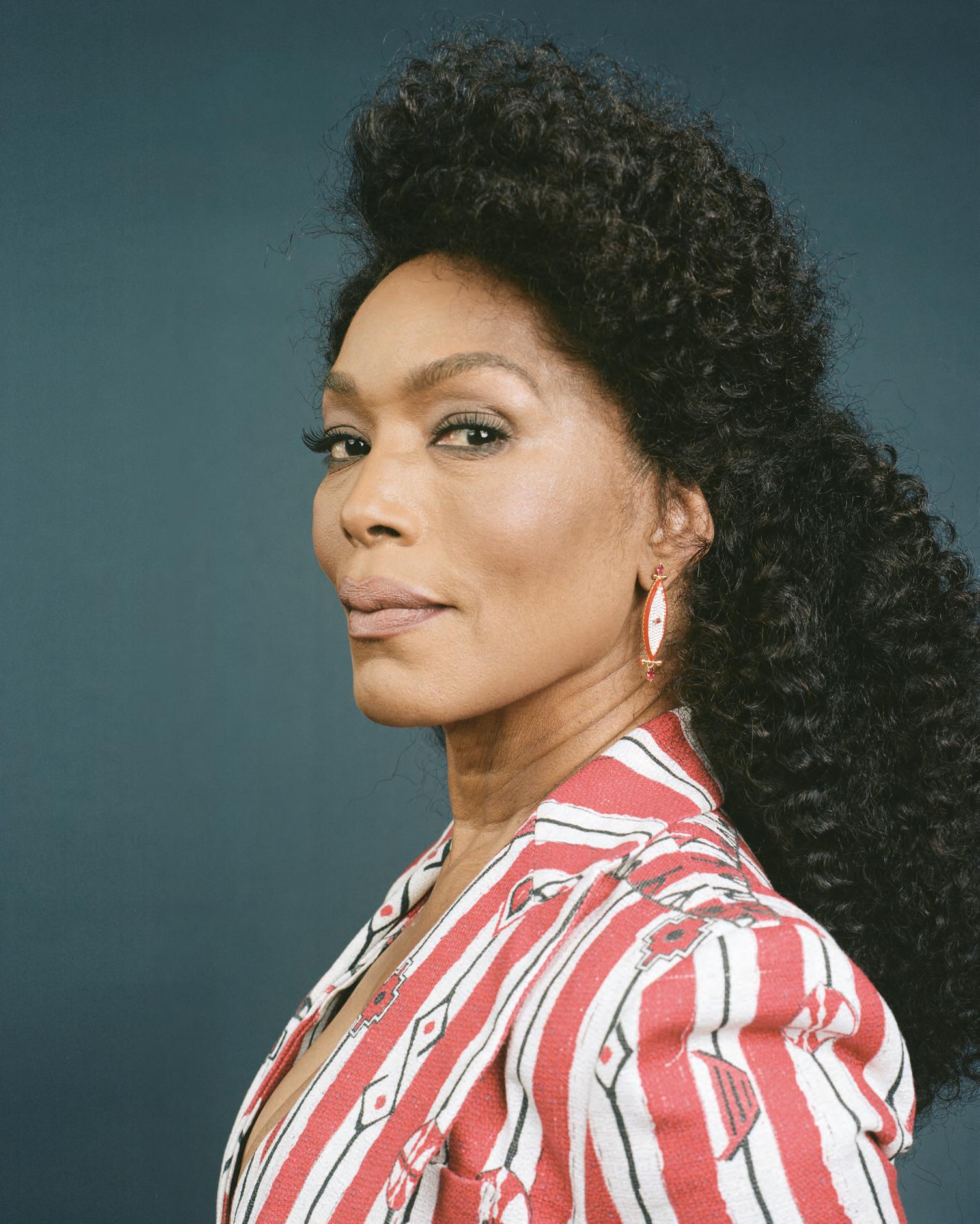
Dialogue 30 ANGELA BASSETT 32 JUDD HIRSCH 34 LUKAS DHONT 36 DOMEE SHI 38 SHAUNAK SEN Handicaps
odds-on favorites.
40 Deadline’s Pete Hammond picks his
MICHAEL BUCKNER FOR DEADLINE

R K
S E T
THE WAIT
He’s been around for 30 years, but Brendan Fraser says his soulful starring role in The Whale couldn’t have come a moment sooner
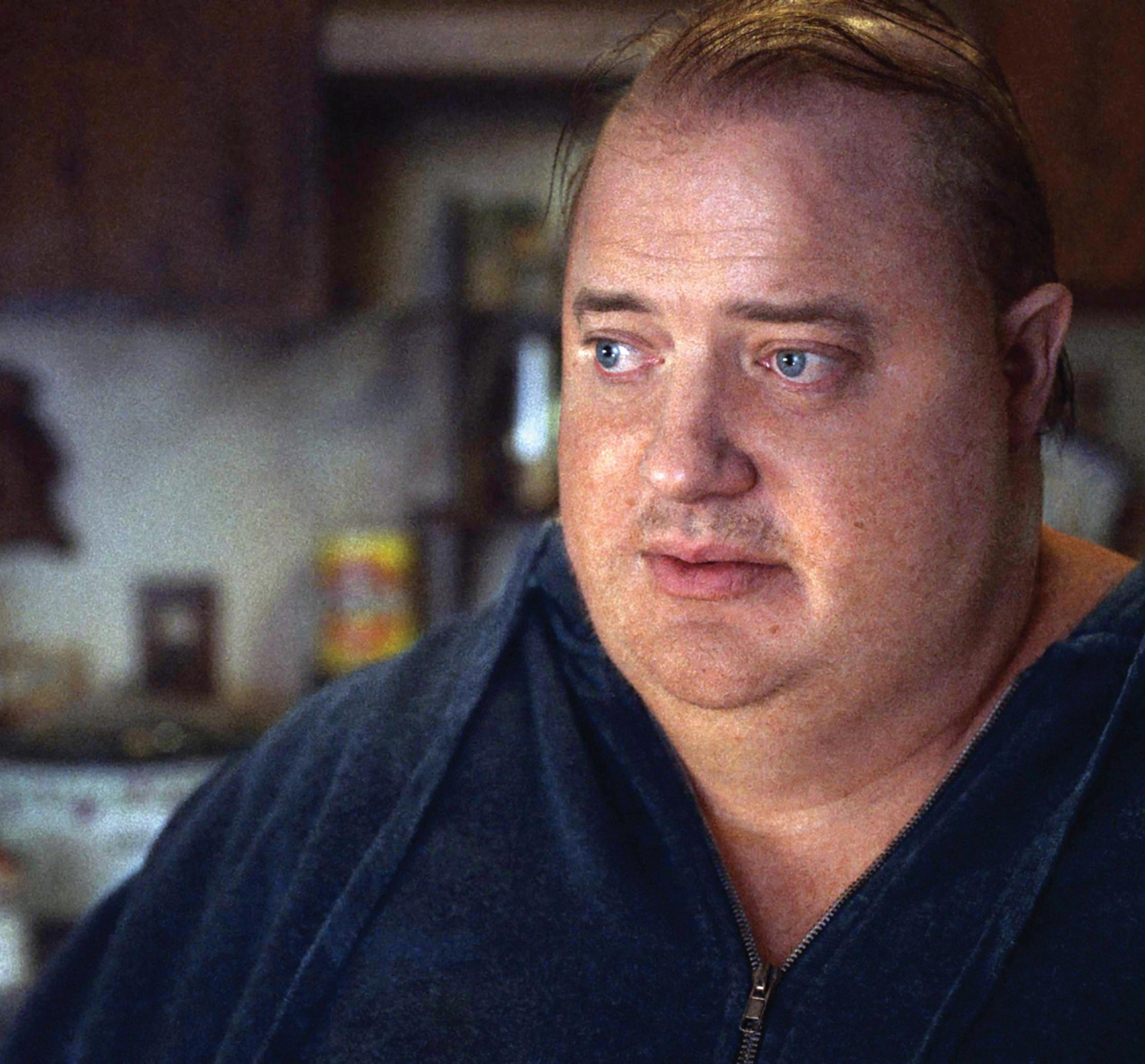 By Stevie Wong
By Stevie Wong
IMAGES/BUENA VISTA 4 DEADLINE.COM/AWARDSLINE
QUICK SHOTS 8 | THE ART OF CRAFT 10 | OSCAR SHORTS 14 | ON MY SCREEN: KERRY CONDON 18
A24/MICHAEL TRAN/AFP VIA GETTY
PICTURES/UNIVERSAL/EVERETT COLLECTION
WORTH
F T I A
Being home must be really nice for the actor after spending countless days on the road attending events and international premieres to promote his critically acclaimed role in Darren Aronofsky’s The Whale. In it, Fraser plays Charlie, a 600-pound writing professor trying to reconcile with his estranged daughter before it’s too late. It’s an awards tour that allows Fraser to not only graciously accept the accolades, but also reflect on the experience of shooting this movie during the worst of the pandemic.
“I’m only too glad to comport myself to all of this, but this is more than just doing a tour,” Fraser says. “Me and my castmates gave everything we had because it was a film made in Covid and we didn’t know if there was going to be a tomorrow. In my view, years from now, we’re going to look back at the movies that were made [during the pandemic] and we’re going to see some kind of secret ingredient to all of them. Everyone lived under an existential threat, and a sincere concern for one another’s well-being
and it’ll show in these performances.”
Before The Whale, Fraser spent much of his 1990s and early 2000s as a fixture in physical comedies like Encino Man and George of the Jungle before landing the part of much-loved hero Rick O’Connell in The Mummy series. Though he received critical acclaim in 1998 for Bill Condon’s Gods and Monsters, Hollywood tended to pigeonhole Fraser into taking on lighter fare, underestimating his abilities. Regularly working the past decade, Fraser featured in ensemble TV series like The Affair and Doom Patrol, but nothing generated the same kind of fervor as his blockbuster past.
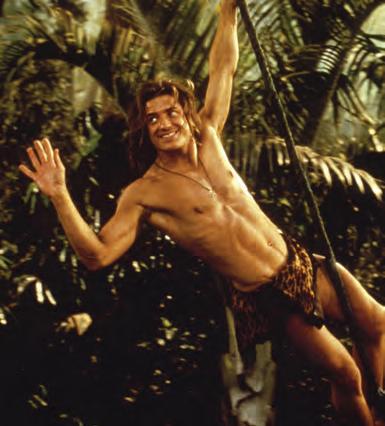

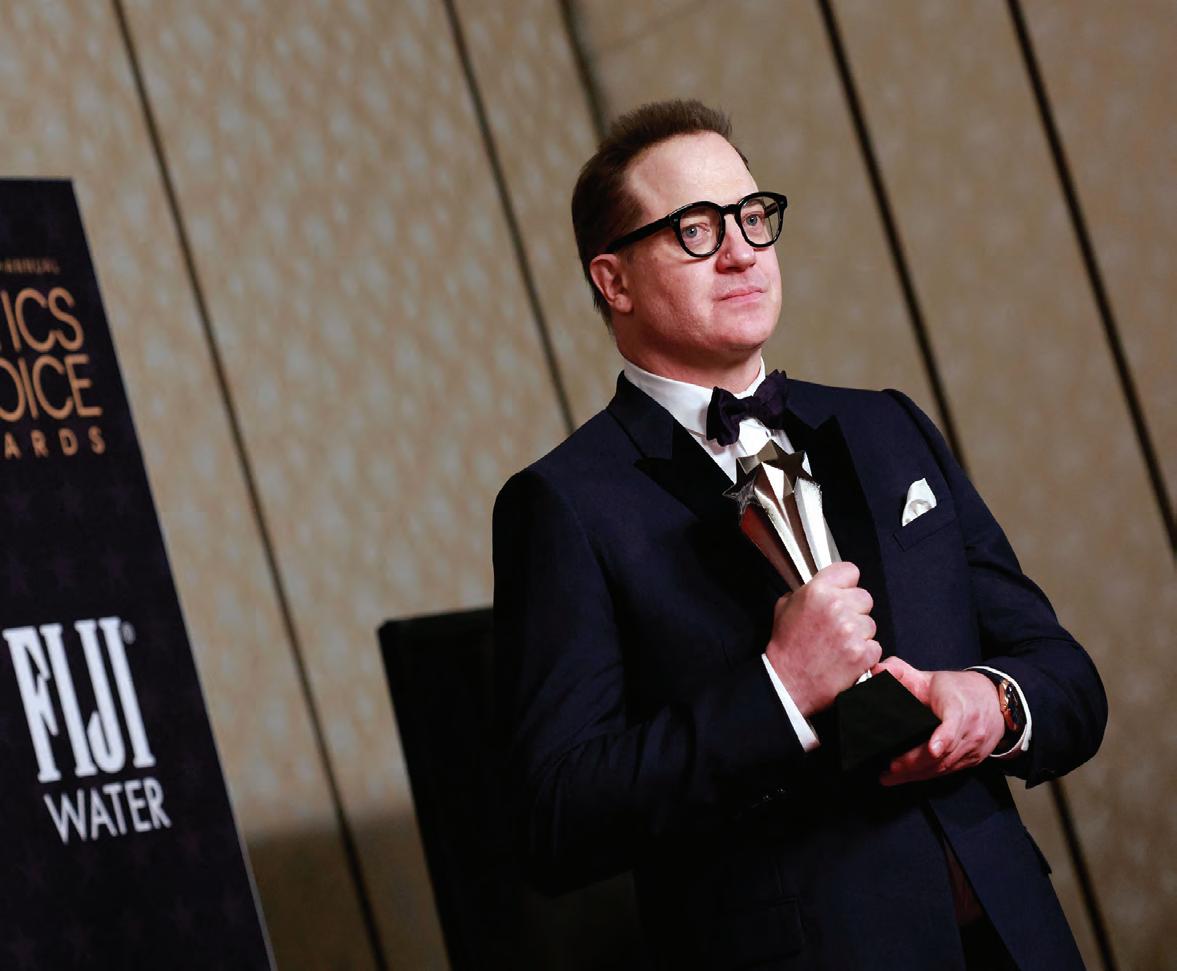
Then, director Darren Aronofsky surprised Fraser by reaching out to him about playing the role of Charlie, adapted
from Samuel D. Hunter’s play, The Whale. “The word on the street was Darren’s making a movie, and he wants to meet you,” recalls Fraser. “My answer… yes. I’m feeling a bit astonished that he even knows who I am, and I arrive at his office with no small measure of creative intimidation from my end.
“I was very delighted to see he’s a gentleman who starts conversations right in the middle,” Fraser says. “He gets right to the substance, which was telling me it’s about a man who is living alone who has been incredibly sad since the passing of his partner and regrets decisions that left him on the other side of custody for his child.
“It was very exciting because it was an opportunity to play a character who is in search of redemption. Then he tells me Charlie’s body weighs hundreds and hundreds of pounds with a health condition where he will die of congestive heart failure very quickly.”
The dramatic combination would be a tremendous uphill battle for any actor to undertake, but Fraser was more than happy and he felt grateful to be considered for this opportunity. “Darren was very frank about finding an actor who could physically create the role from the outside, but also give a performance that had an emotional depth,” Fraser says. “He was basically showing me his chessboard of how he was going to approach it, and I immediately wanted to stand next to him and help him figure out how to make all the pieces work together.”
“Then March 2020 rolled around, and we all know what happened,” Fraser remembers. “We went home to put on our comfortable pants.”
Fraser assumed that the project was over. Then months later, plans began to make the film possible with extensive safety protocols. But there was a
“Sorry I’m a few minutes late, I’m just trying to situate my lap dog,” apologizes Brendan Fraser from his upstate New York home. “Isn’t it funny in this age of Zoom, we can’t pretend we’re not at home anymore,” he laughs.
George of the Jungle
The Mummy
Left, Fraser with the Critics Choice award he won for The Whale .
problem with getting him fitted for a suit virtually.
“Instead of going through a normal compounding process of creating a mold of my face, Adrien Morot [prosthetic makeup designer] could only work off a 3D scan virtually,” Fraser says. “That was done in my driveway by Jeremy [Dawson, producer], who showed up with an iPad, but my dog kept scurrying in at my ankles. The result, however, is seamless, down to the micro size of Charlie’s pores.”
“When we finally got together to make the film, I had my first makeup test with the suit, and Darren looked over my shoulder and said, ‘For the rest of your life.’ I knew then that if I wanted to be up for this test, I had to own it. So, from that point forward, I learned how to exist as Charlie in this five-point harness suit
that had conforming weight and a unitard with pipes running cold water through it. I also worked with our movement coach Beth Lewis, and we worked on centers of gravity, inertia to stand, and the support conditions that people who live with obesity have to have. My job was to sell it because, until this point in films, we haven’t seen a costume and makeup done with this kind of dignity and respect.”
Looking back at Fraser’s most popular performances, his fearless physicality played a big part in the characters he played. That list now includes Charlie. “I’ve always sought to find a physical body objective in whatever I’m doing. If it’s an action movie, I’ve found that it’s best to play the next scene, not the one you’re in. In other words, if I’m in a film where the end goal is to get to the car, all the scenes I’m in beforehand lead to that final goal. So, for Charlie, I have to get to the end of the hallway to the bathroom, not to use it, but not to let my daughter see me cry.”
Though the physical aspect of Charlie needed to be perfected for the screen, Fraser had to figure out how to give a respectful performance that would honor this character. “Charlie has a secret superpower,”
Fraser says. “He is able to bring out the good in others even when they can’t see that in themselves or they feel that they’re irredeemable. He appreciates beauty in the humanities and is a composite of people I’ve known; teachers I’ve had from back in the day, drama tutors I’ve worked with, friends I’ve made and lost.”
Playing Charlie also allowed Fraser to collaborate with
the Obesity Action Coalition to understand the daily battles obese individuals face. “Obesity is an affliction and a disease for people who deserve our empathy and our help and our respect. Because how they present to the world means that they can’t get adequate healthcare. They’re passed over and diminished in societal settings and ridiculed in media. You can really harm someone’s physical health by the way you speak to them. I know that many people who live with obesity said
when they were children, something said to them set off a cycle in their lives. In fact, a woman wrote to Darren last week and said she was frightened to get a bariatric procedure and she’s now going to after seeing the film. It will save her life. That was the hope we went into it with, to change some hearts and minds in an unsolicited, uncynical, cathartic way.”
Fraser also acknowledges that he couldn’t have played the role of Charlie earlier in his career. “I didn’t have the life experience or the heartache. I hadn’t been a father long enough 10 years ago to appreciate what it means to have a young person in your life.”

But the memory of Charlie is still a part of Fraser. “When this film was over, I had an unexpected reaction to taking off Charlie’s body the last time; I was really emotionally moved. I felt a strange sense of survivor’s guilt because I could take him off at the end of the day, and I’ve met people who live like that until they didn’t live anymore,” Fraser reflects. “I’ve had to take a page of my own sermon and rethink if I’ve been culpable or demeaning and overlooked them. Even if I did accidentally, I don’t ever want to do that again going forward.”
When The Whale premiered at the Venice Film Festival, a video of an emotional Fraser getting a six-minute standing ovation went viral, immediately placing him at the forefront of the awards conversation. But as an actor with more than 30 years of experience under his belt, his response to all of this has been extremely humble. “I approached this film as if I will never be called upon to do it again,” Fraser says. “I made myself vulnerable to everyone, and I find it liberating because I have nothing to hide or prove. I have nothing but respect for everyone who sees it, even the people who disagree with the material artistically.” ★
 Above, Fraser as Charlie in The Whale ; left, Fraser, Sadie Sink and Darren Aronofsky in New York.
Above, Fraser as Charlie in The Whale ; left, Fraser, Sadie Sink and Darren Aronofsky in New York.
6 DEADLINE.COM/ AWARDSLINE A24/TAYLOR HILL/WIREIMAGE FT CLOSE-UP
“I felt a strange sense of survivor’s guilt because I could take him off at the end of the day, and I’ve met people who live like that until they didn’t live anymore.”

Charted Territory
At press time, here is how Gold Derby’s experts ranked the Oscar chances in the Best Picture race. Get up-to-date rankings and make your own predictions at GoldDerby.com.
In Tempo
Editor Monika Willi on piecing together the musicality of Tár
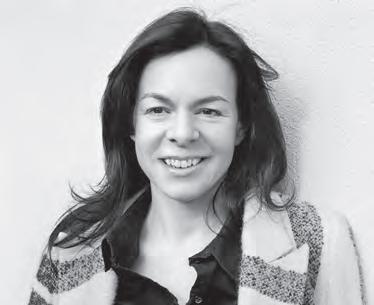
For Tár, director Todd Field had a very precise vision for the film. Editor Monika Willi’s job was to “create the musicality and tempo that has been predetermined by the scenario.” In the film following conductor Lydia Tár, played by Cate Blanchett, balancing the tempo and rhythm of each character was essential. “It really means, what are the beats-per-minute for a scene…

and to construct a composition that allows every character to have its own pace.”

As the film tracks Tár’s catastrophic fall from grace, the composition of the scenes also needed to change. At the beginning of the film, Willi says, “We allowed her the space she needed in the scenes, and got tighter and tighter at the very end, to create a musicality from the first
scene to the last scene in the overall composition.”
While maintaining the balance of this composition was a challenge, Willi says the most important thing was for the film to be sharp, precise and to the point. “Overall, it’s a film that never loses tension,” she says. “It’s about being really constant in the tension and in the gripping of the audience.” —Ryan
Fleming
Sound of Silents
How Composer Justin
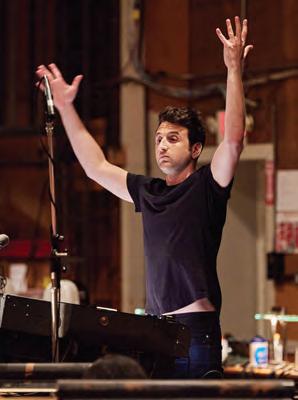
Hurwitz scored the chaotic splendor of Babylon
Hurwitz incorporates a rich and explosive ensemble of harmonies to compliment the grandiose vibe of 1920s Hollywood. “ Babylon mixes up a lot of influences,” he says. “It has some jazz influences, rock ’n’ roll and contemporary dance music
in the music. There’s a lot of Middle Eastern and Latin flavors, orchestral cues and a lot of circus sounds in the score.”

To execute this larger-
than-life eclectic mix of tunes throughout the score, especially that of the soundtrack highlight “Voodoo Mama”, Hurwitz, along with his 98-piece orchestra, got experimental.
“The pieces of music that are either a jazz band or like montage cues that use the same sound were: two trumpets, three saxes, two trombones, a tuba, a banjo or guitar, drums, a piano and then many layers of additional percussion. We had a group of African and Latin percussionists come in and add a lot of layers,” Hurwitz says. “In the track ‘Voodoo Mama’, there are layers of me slamming wood boards on the floor of my home, and layers of me doing kazoos and slide whistles.” —Destiny
Jackson
8 DEADLINE.COM/ AWARDSLINE 1 Everything Everywhere All at Once ODDS 13/2 2 The Banshees of Inisherin ODDS 15/2 3 The Fabelmans ODDS 8/1 4 Top Gun: Maverick ODDS 8/1 5 Tár ODDS 9/1 6 Elvis ODDS 9/1 7 All Quiet on the Western Front ODDS 19/2 8 Avatar: The Way of Water ODDS 23/2 9 Triangle of Sadness ODDS 13/1 10 Women Talking ODDS 13/1 Best Picture
FT QUICK SHOTS FLORIAN HOFFMEISTER/FOCUS FEATURES/PARAMOUNT PICTURES/EVERETT COLLECTION
Top, Composer Justin Hurwitz; left, Li Jun Li in Babylon.
Cate Blanchett in Tár

THE ART OF CRAFT
How production designer Christian M. Goldbeck created a “topographical dystopia” for All Quiet on the Western Front

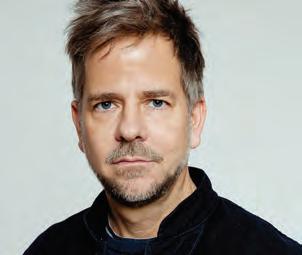
 By Ryan Fleming
By Ryan Fleming
Goldbeck found very rare non-propaganda photographs of the battlefield and trenches to use as the basis of the build.

Trenches were created using the same materials that were used in 1917—mostly wood sourced from multiple locations.
The trenches had to be reinforced with concrete for the scene where tanks destroy them, so the tanks wouldn’t sink into the mud.

10 DEADLINE.COM/ AWARDSLINE FT THE ART OF CRAFT
“We decided in a very early stage to make it visceral and physical, to show what we can lose in war,” says production designer Christian M. Goldbeck. “To beautify war would be propaganda.”
ANNE WILK/CHRISTIAN M. GOLDBECK/COURTESY NETFLIX
All of the technical drawings for the film are based on archival plans used to build the original wartime trenches.
From Top: Concept art; the design of the destroyed French trenches with photographic references. The trenches after filming.

The location started as a flat piece of land, so the production needed to bring in 20 diggers to transform the landscape and a crew of people to mold the craters into rounder shapes.

Originally set to be the size of two football fields, the battlefield was expanded to four fields' size so they could capture the scenes without stopping to edit.
Building started in January, when the ground was still frozen, and construction took three and-a-half months.

Routes were created for the actors to navigate the battlefield easily, while the rest of the area was surrounded by craters.

CHRISTIAN M.
FT THE ART OF CRAFT
GOLDBECK/COURTESY NETFLIX
12 DEADLINE.COM/ AWARDSLINE
Above, from top: A topographical map of the battlefield, and trench designs with photo references. Below: An aerial view of the battlefield.

SHORT CUTS
From social justice to adolescent romance, this year’s Oscar-nominated filmmakers don’t take long to make their points
LIVE ACTION SHORTS
An Irish Goodbye, written and directed by Tom Berkeley and Ross White, is a dark comedy that follows a pair of estranged brothers who must learn to get along after their mother’s untimely death. Berkeley’s own views of loss inspired the film’s exploration of love and grief. “It’s about reconnection, redemption and the idea of how, in the darkest moments for those two characters, they end up finding each other through their commitment to their mom and their mom’s memory,” he says. “Grief is something that we think of as a very personal, individual journey, but it’s something that you don’t necessarily have to go through alone, and
grieving with another person can lead to healing.”
For Iranian director Cyrus Neshvad, bringing the story of The Red Suitcase to life was urgent. The film follows the harrowing journey of a 16-year-old Iranian girl as she attempts to flee an airport undetected by the man that she’s been sent off to marry. An instrumental scene involves the girl removing her hijab for her safety, but at the risk of defying her culture. “Women are disappearing and never coming back, sometimes because of how the hijab is worn on their hair,” Neshvad says. “I was terrified, but I wanted to talk about it because it’s also my home country. When I did this movie, I said, ‘I want a woman who has the choice to take this off, even if it’s for her freedom, for her free will.’”
Eirik Tveiten’s Norwegian short Night Ride begins after a late-night mishap. Ebba accidentally steals a local tram, and along the way, she picks up Ariel, who attracts the attention of a man sitting nearby. Things get hostile when the man uncovers that Ariel is a transgender woman. Along with witnessing passengers, Ebba must decide if she’d rather stay out of the kerfuffle or risk getting involved. “Norway is the best country in the world to live in, but we struggle with the same issues of prejudice,” producer Heidi Arnesen says. “Eirik came to us with this idea about social responsibility, and we have to act when someone is being treated unjustly.”

The Greenlandic tale Ivalu focuses on a young girl searching for her missing older sister. Adapting a story centered around the sexual abuse of children was a delicate matter for director Anders Walter. “Taking on a story like this, you’re very much aware that you’re dealing with something that affects a lot of young people, and it’s a very sensitive
subject matter,” he says. “It’s always a balance because you don’t want to come across as naïve, because that would be the worst thing if the victims couldn’t recognize themselves in the story. And by talking to people working with children in this situation, they talk about the community around these victims.”
Le Pupille, an Italian religious comedy, written and directed by Alice Rohrwacher, is set at an all-girls Catholic orphanage during 1940s wartime. While on Christmas break, the girls face the greatest temptation, trying not to eat a delicious zuppa inglese cake. “I wanted to create a film that was out of time,” she says. “That was classic but also handmade. I wanted to show the girls that you can have something magical without incredible things.” —Destiny Jackson
ANIMATED SHORTS
After receiving such a positive response to his 2019 book The Boy, the Mole, the Fox and the Horse, creator Charlie Mackesy was excited to bring his book to life and allow the story to affect people in a more “stimulating” way. “Strangely, before I even made the book I felt they could move,” he says. The animated short follows a boy searching for a home. Along the way, he meets three animals who are also looking for a place

to belong and begin to develop a bond. “The inspiration was the desire to make people, friends or whoever, feel better about things,” he says. “All of us were struggling at the time with things and it seemed good to be able to lay out those issues in a conversation.”
Filmmakers Wendy Tilby and Amanda Forbis were inspired to make The Flying Sailor from a small blurb about a sailor they found while researching the Halifax explosion of 1917. “He was launched and flew for two kilometers and landed unharmed and naked except for one boot,” says Tilby. As they were captivated by the flight aspect, their animated short takes a slowed down look at life flashing before a man’s eyes as his “balletic” movements are underscored by a beautiful piano. The animation style blends 2D and 3D elements, which Forbis says created a “cartoony” opening sequence that contrasts the tragedy of the situation.
Like many of his other films, João Gonzalez’s Ice Merchants began with an image from his subconscious. “It was an image of a tiny house attached to a cliff,” he says. “I knew the theme

DISNEY+/APPLE/COURTESY EVERETT COLLECTION/EIRIK TVEITEN FT FOCUS ON: SHORT CATEGORIES
Le Pupille
The Boy, the Mole, the Fox and the Horse Night Ride

of the film was going to be about loss, but all the tiny details of the narrative are about finding joy.” The short follows a father and son living on a house attached to the side of a mountain. While animated digitally, the artistic style emulates a handdrawn pencil on paper look with bold shadows and a limited color palette that contrasts the “human side of the characters with the cold, harsh colors of the outside.”
Based on a chapter of Pamela
Ribon’s memoir Notes to Boys: And Other Things I Shouldn’t Share in Public, My Year of Dicks follows a 15-year-old Pam on a comedic journey to find the right boy to lose her virginity to. “I was raised on romance novels and films in the ’80s,” Ribon says, “so I was ready to get it done because that’s what I thought you were supposed to do—you only became a woman once you lost your virginity.” The short was split into five different chapters, following different boys with unique styles of animation to simulate the “overwhelming, all-encompassing feeling” of a crush. “I always imagined him in a very different light than anybody else did,” she says, “in whatever phase I was going through at the time.”
Lachlan Pendragon began his work on An Ostrich Told Me the World Is Fake and I Think I Believe It from a research perspective by questioning what he found appealing about stop-motion. “For me, stop-motion is all about those tactile qualities and imperfections,” he says. He admits that he went a bit too far with it and ended up creating a “ridiculously meta and very self-referential” short about an office worker spiraling after an Ostrich reveals that he is in a stop-motion animation. As Neil, voiced by Pendragon, learns of the nature of his world from an ostrich, he starts to notice things that confirm the suspicion. “It sounds very horrific when you think about a stop-motion character finding out their face can fall off,” Pendragon says. —Ryan Fleming
Documentary Shorts
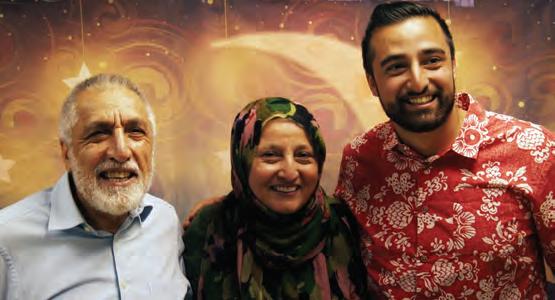
Filmmaker Jay Rosenblatt enjoyed a lengthy and distinguished career in documentary without ever being honored with an Oscar nomination. He ended that drought last year with When We Were Bullies, and now finds himself an Oscar nominee for the second consecutive year, this time for another personal story, How Do You Measure a Year? The short film comprises interviews with his daughter Ella recorded as she grew up. Once a year on her birthday, from age two to 18, Rosenblatt asked her the same set of questions—like, what are dreams? What is power? “I had no idea this would be a film,” the director observes. “I didn’t even look at the footage [for 17 years]. Each year, I would just film it, put it away and just hope for the best.”
Joining Rosenblatt’s latest in the short documentary category are two films from Netflix—The Elephant Whisperers and The Martha Mitchell Effect. The latter film, directed by Anne Alvergue and Debra McClutchy, examines a woman who helped
expose the Watergate scandal that ultimately destroyed Richard Nixon’s presidency. As the outspoken wife of John Mitchell—Nixon’s former attorney general, and head of his 1972 reelection committee—Martha Mitchell was in a position to reveal secrets about the scandal. As a result, the president’s men deliberately besmirched her as an unstable alcoholic. “She was essentially a victim of a gaslighting campaign from the Nixon administration to silence her and stop shedding the
spotlight on the Watergate scandal,” Alvergue says.
The Elephant Whisperers earned filmmaker Kartiki Gonsalves her first Oscar nomination. It’s the story of a couple charged with raising orphaned elephant calves in a nature reserve in South India. Youngsters like the rambunctious elephant Raghu need a lot of affection and receive it in
abundant supply from partners Bomman and Belli. “Raghu felt like he was with a mother, he had a father,” Gonsalves says of the relationship between the pachyderm and his human caregivers. “That gave him that family feeling, which they usually have because elephants are very emotional, sentient beings and they emote so much love and care toward their babies.”
Human and animal interaction of a different sort constitutes the theme of another nominated documentary short, Haulout. The film, directed by sister and brother Evgenia Arbugaeva and Maxim Arbugaev, follows a researcher in a very

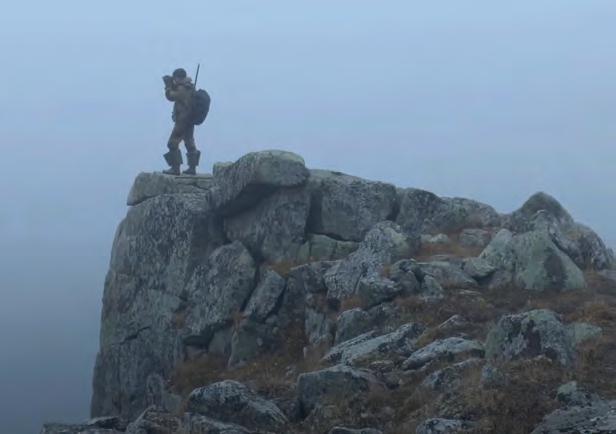
remote outpost of the Siberian Arctic. Marine biologist Maxim Chakilev studies walruses, which congregate in massive numbers at Cape Serdtse-Kamen. Warming seas have placed enormous pressure on the giant creatures, who no longer encounter floating ice where they can take a breather while feeding. “It was just the three of us feeling our smallness, among this huge amount of animals,” Arbugaeva tells The New Yorker, which distributed the film. “Sometimes that line between human and animal was blurry. You start to tune into what they potentially could feel.”
The New Yorker also released Stranger at the Gate, directed by Joshua Seftel. It centers on Richard ‘Mac’ McKinney, a Marine Corps veteran who fought in Iraq and Afghanistan. After he left the service, he harbored deep suspicion and hatred towards Muslims and hatched a plan to attack an Islamic Center in his hometown of Muncie, Indiana. But while conducting reconnaissance for his bombing plot, he met congregants and, somehow, they reached his heart, gradually transforming his fury into love. “This is a story I believe we need right now,” Seftel says. “It’s about America, and its deep problems. But it’s also about hope.” —Matt Carey
16 DEADLINE.COM/ AWARDSLINE GRIFFITH
FILM SCHOOL/THE NEW YORKER/ALBIREO FILMS/COURTESY EVERETT COLLECTION
FT FOCUS ON: SHORT CATEGORIES
Haulout
An Ostrich Told Me the World Is Fake and I Think I Believe It
Stranger at the Gate

KERRY CONDON
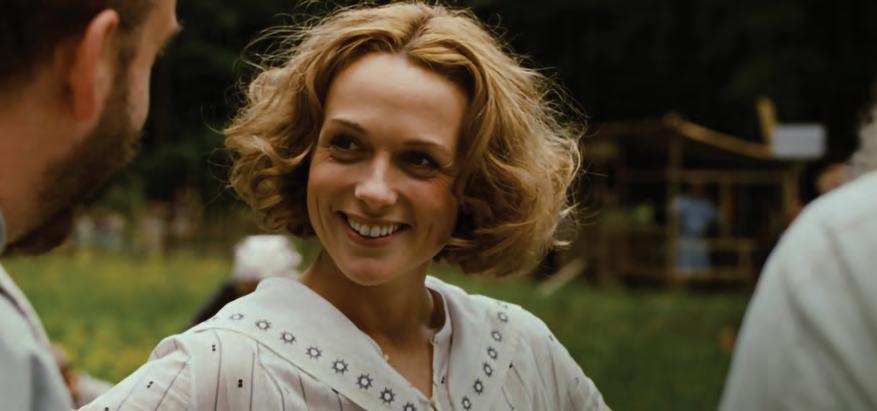
The Banshees of Inisherin star reveals career advice, her desert island movies and why acting life isn’t all Brad Pitt all the time
By Antonia Blyth
When Kerry Condon heard her Oscar nomination announced in the early hours of the morning in LA, she was clustered around the television with a group that included her Banshees of Inisherin co-star Colin Farrell. “I remember thinking, ‘Oh Jesus, hang on though. What if it’s bad for one of us?’” Condon says. Fortunately, neither actor was left out in the cold. Making Banshees was a chance for the actress to reunite with writerdirector Martin McDonagh, in whose plays and the film Three Billboards Outside Ebbing, Missouri she had already starred. The Banshees character of Siobhán lets Condon show us her chops—from a scene in which she gently lets down the amorous but tortured young Dominic (Barry Keoghan), to telling Brendan Gleeson’s bull-headed Colm (and men in general), “You’re all feckin’ boring!” Here, Condon reflects on her career thus far and some of her onscreen favorites.

My First Film Lesson
It’s a good one. I learned it and I was also told it. You have to be prepared to make a fool of yourself
You just have to have no shame, basically, to be a good actress. You have to go big and then you can
reign it back. But you have to have balls to go big, because you might look like an idiot, but unless you go big, you’re holding back.
Nick Nolte told me a story about an acting class he did with Marlon Brando.
Marlon Brando said nothing and just sat there in
this chair, and then started to slowly put makeup on and change his outfit and basically made himself absolutely ridiculous with the makeup and the clothes, and that was the lesson at the end: when he was all done and he looked crazy, he was like, “That’s the
lesson you need to learn. You have to not be afraid of making a complete fool of yourself and looking like a complete idiot.”
The Best Advice I Ever Received
Keep your expenses low. Because listen, I can be here all day giving you creative advice, but ultimately if you do one TV show and then you’re out blowing your money on a big car that’s costing you three grand a month, and then you think you’re living the dream in this big huge house, because you want to act like you’ve made it, that’s grand. But the job is going to end, and then you’re going to be unemployed. And how are you
going to pay for this life that you have? And that’s a mistake so many people make. They just think they’re going to be making that money all their life, and you’re not going to be making that money all your life. There’s going to be a period where you’re not going to be making money at all. Keep your expenses low and also it just frees you up, then you’re more free artistically, because it’s not this notion of, “I have to get a job because I have to pay for this.” You can sit back a bit more and go, “Do I want to do this job?”
The Part I Always Wanted
I don’t have a part that I want to do in the future or
18 DEADLINE.COM/ AWARDSLINE SEARCHLIGHT PICTURES/SAN JOSE STAGE COMPANY/HBO/UNIVERSAL/WARNER BROS./EVERETT COLLECTION
FT ON MY SCREEN
Top, Kerry Condon in The Banshees of Inisherin; above, in Three Billboards Outside Ebbing, Missouri.
anything. I don’t think like that. I just kind of go with what’s in front of me, and if I feel like I want to do it. I never daydream on a part that I’d love to play or anything. But I suppose all the parts that I want, the parts that I really liked, that I wanted, I got. [McDonagh’s play] The Lieutenant of Inishmore would’ve been a part I really wanted, and then the part in [television series] Luck was another one that I would’ve really, really wanted.
The Most Fun I’ve Had On Set

Sometimes I get annoyed if people are having too much fun. I’m like, “This is a business, guys. It’s not fun and games.” You know, I’m pretty serious. I’m always ready, and I don’t be wasting money or dicking around. So, I can’t say I’d be having loads of fun now, but let me think. I mean, I’d probably say Luck, again. Because when I wasn’t on the set I was riding on a racetrack and that was a lot of fun. Getting to ride racehorses on a racetrack, for me, that feeling was so amazing. Also, I don’t want to give off this notion that acting is so amazing and we’re having this laugh all the time. It’s not, it’s really lonely. You’re having a great time and then you’re in a hotel room in the middle of nowhere in New Mexico and you’re alone. Nobody talks about that because everyone wants to think that you’re at
the bar with Brad Pitt every evening having a whale of a time. It’s just not true.
My Toughest Challenge
It’s been navigating the press part of the job, because I’ve never done it before, not to this extent. And I never knew that it was part of being an actor, at all. And I don’t think anyone does know that until it happens to them. I’m so glad it’s happened to me now at 41, because I think if this had happened to me in my early 20s, God only knows what would’ve come out of my mouth. I looked at Cate Blanchett with different eyes, because not only was she this brilliant actress, but also I was like, ‘Oh my God, you are still hustling. You are still turning up with these awards and doing these interviews and all. And you’ve been doing this for how many years?’
The Films That Make Me Cry
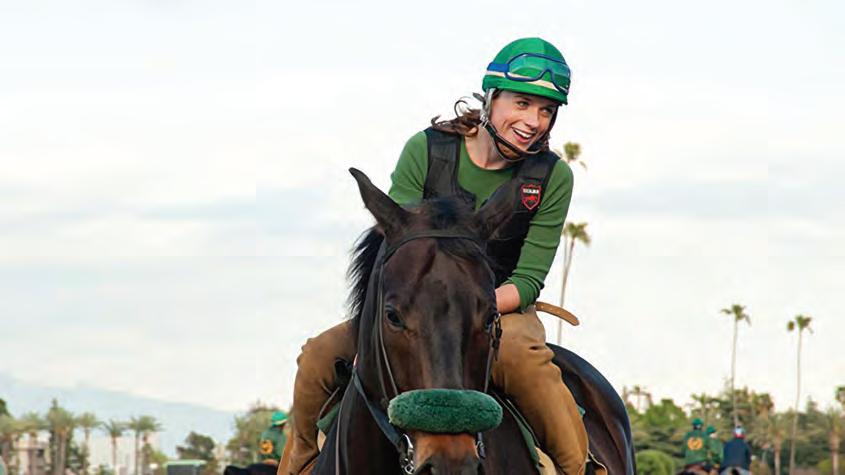
For somebody who’s not that crazy about getting married, I’m such a romantic. So, The Bridges
of Madison County. My brother still to this day talks about it, because he grew up in a house full of women. He was like, “I remember you were all crying over that film.” So, anything romantic, obviously. And I mean, there’s obviously Marley and Me, but I don’t even need to explain why. It’s funny, I was teasing my brother the other day because he nearly started crying at the end of Top Gun, and the only reason he didn’t was because of the fella beside him in the seat on the airplane. He was afraid the guy was going to be like, “Oh my God.”

The Character That’s Most Like Me
Maybe Siobhán. But people know that Siobhán was really dignified in the sense that she didn’t need people to know she was very intelligent, and stuff like that, whereas I kind of do. Well, I mean I don’t need people to know, but I wasn’t as dignified as her. I’d say all of the parts have got bits of me in them, but Mairead in The Lieutenant of Inishmore,
maybe. At that time in my life anyway, when I played her, it was very close to who I was and what I believed.
My Desert Island Movies
Jesus Christ. A desert island means what though? That you want to have a laugh or something? But a film I might never get sick of? Parenthood. Ron Howard’s film. I re-watched it recently, and I was like, Jesus, now that I’m older I really see the parenthood theme of it, and I used to relate to the kids. But you know what’s funny, they’re saying that Steve Martin is 35 and I was like, OK, he doesn’t look 35 in it. The benchmark then was Steve Martin with his gray hair. He was 35. I was like, Christ, that makes me feel like I’m 90.
Hannah and Her Sisters by Woody Allen. I think all the actresses in that were brilliant. I’ve always been a big fan of Dianne Wiest. I mean, I know that’s
topical to say that right now [regarding Allen], but I don’t want to discredit performances that really I thought were brilliant.
I mean, there are loads of them. This Boy’s Life, The Lost Boys, The Golden Child
The First Film I Saw In A Theater
Yeah. I was actually asked to review The Lion King. It was the first professional paycheck of my life. I was about 10. In the summer I was at home, and on the radio there was a debate going on about people from the country versus people from the city. And we were from the country. I rang into the radio and said, “People from the city think they’re so brilliant, well they’re not.” So anyways, the radio rings me back and they were like, “Would you like to review a movie for us? Would you like to go to The Lion King?” My review was, “It was excellent. I thought it was really good. I thought it was brilliant.” ★

DEADLINE.COM/ AWARDSLINE 19
Luck
The Lieutenant of Inishmore Parenthood
The Bridges of Madison County

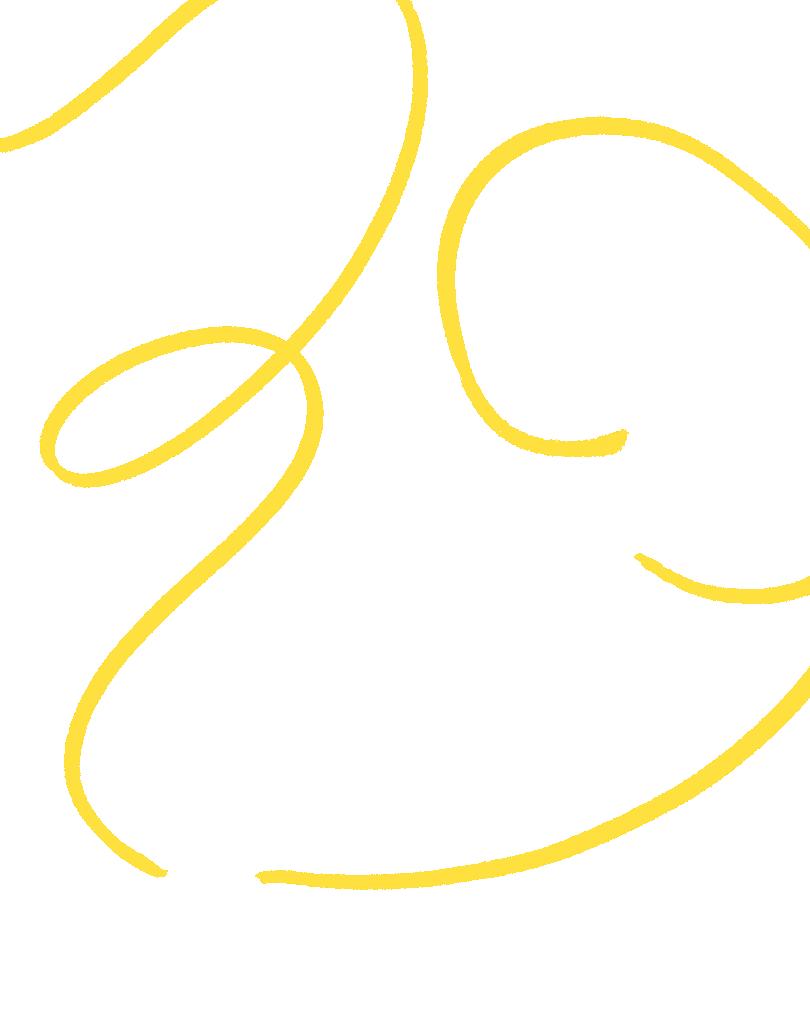
Michelle Yeoh never imagined a path for herself that would lead to her mind-bending performance in Everything Everywhere All at Once, the film that has made her Oscar’s first Best Actress nominee openly of Southeast Asian descent. After a lifetime spent breaking down barriers, she tells Joe Utichi how it feels to have at last been invited to the ball.

Photos by Josh Telles for Deadline





DEADLINE.COM/ AWARDSLINE 21
Michelle Yeoh’s mother is a worrier. Janet Yeoh has spent the past four decades watching her wildest dreams for her daughter come true. She has witnessed her ascent from Hong Kong action heroine to Oscar-nominated international icon. But when she saw Everything Everywhere All at Once—the film that has brought Michelle Yeoh the best reviews of her career, and that landed her an Oscar nomination for Best Actress, breaking new ground for Southeast Asian performers—Janet had one main reaction: “ Why do you have to look so old? ”
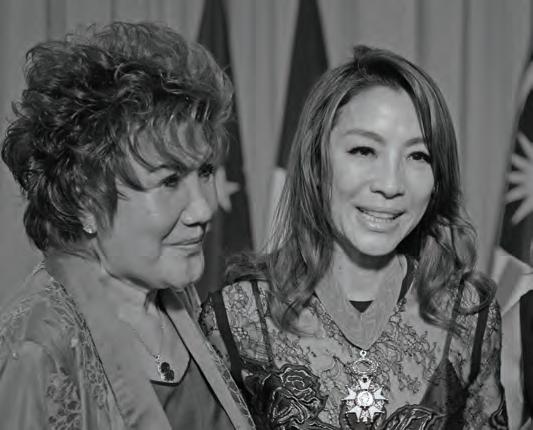
“She still treats me like I’m six,” laughs Michelle Yeoh, settling into lunch at a Michelin-starred eatery in London and looking every bit as chic as she does at any red carpet event. A superficial observation it feels important to include when Yeoh adds that if her mother could see her now, she’d almost certainly say to her, “Did you comb your hair? Why don’t you put on some make-up, and wear a nicer dress? ”
“If we were back home right now, she would have laid some clothes out for me,” Yeoh says. "It’s how she shows love."
It might be this universal truth of motherhood that has made Everything Everywhere All at Once—a multiverse-bouncing treatise on complicated family dynamics from directors Daniel Scheinert and Daniel Kwan—such an unlikely awards frontrunner. Yeoh’s character Evelyn has such a tenuous relationship with her daughter Joy (Stephanie Hsu), that in some obscure alternate universe, an even more extremely dispirited version of Joy called Jobu Tupaki would rather dispatch with all known existence than endure any more of her mother’s misunderstanding.
But what Joy can’t comprehend about Evelyn is that her mother worries because she wants nothing less for her daughter than the best possible life. Her
definition of what that looks like may have to change, but Evelyn Wang is a true warrior for her family. “Moms are the real superheroes,” says Yeoh. “They carry the weight of the world on their shoulders every day. So many women do that. They march on steadfastly, but nobody ever gives them the superhero cape.”
YouTube, which has become a repository for so many wonderful things that might otherwise have been consigned to obscurity, you can find Michelle Yeoh’s first screen appearance. It is a commercial from 40 years ago for Guy Laroche watches, though it requires the constant voiceover of a narrator repeating the brand name to make any sense of what’s being promoted. Instead, the action on screen sets Yeoh and Jackie Chan by a lake. They ride past one another time and again, swapping horses for motorcycles, for mopeds, for bicycles. Their characters are, perhaps, falling for one another over a series of overengineered meet-cutes—after all, their passage seems far away from anything that might reasonably be classed a daily commute—but
it’s impossible to speak with any kind of certainty about the ad’s storytelling logic.
As screen debuts go, it is not the finest showcase for Yeoh’s talents. And yet, as she giggles at Chan comically toppling from his bike in one scene, there’s a comfortable ease on her face that suggests Yeoh may have found her vocation.
Inside, she says, her stomach was churning. She had signed up without paying much attention to the identity of the man they told her would star opposite She had grown up in an English-speaking household, and Sing Lung, the name they’d given her, was Chan’s Chinese name. She didn’t know it. It was only on the day of the shoot that the penny dropped, as one of the biggest stars of Asian cinema walked up to her.
But if the ad itself is largely incomprehensible, the screen presence of its female lead was enough for D & B Films, the nascent production company that had made the commercial, to offer Yeoh a contract for a feature film. She recognized the names behind the company—Sammo Hung’s reputation as an actor and director was already established, and it was co-founded by businessman Dickson Poon— but the immediate offer felt hard to trust, and she didn’t understand the complicated document

CHRISTOPHE
22 DEADLINE.COM/ AWARDSLINE
Michelle Yeoh and her mother, Janet Yeoh.
ARCHAMBAULT/AFP VIA GETTY IMAGES
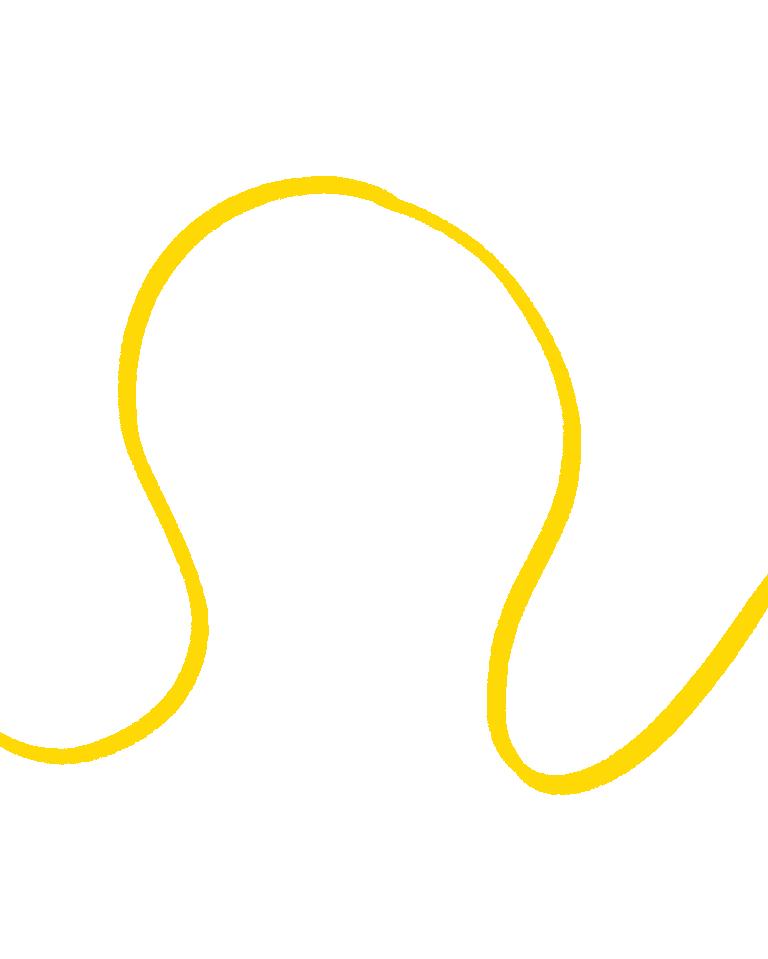
DEADLINE.COM/ AWARDSLINE 23
they’d handed her. In fact, their offer simply seemed too implausible to be true: ‘Sign this and become a movie star.’
Yeoh had loved movies her entire life, but she had never connected the figures on the big screen with a career that real people participated in. “We didn’t really have a film industry in Malaysia at the time,” she says. “I was looking up on that big screen at Christopher Lee as Dracula, or watching musicals like The Sound of Music, but I never, ever thought it was something I could do.”
In fact, she had already experimented with acting and determined it wasn’t for her. Her first passion had been dance. Born Yeoh Choo Kheng in Ipoh, Malaysia’s fourth largest city, she found ballet when she was just 4 years old. It became her childhood obsession, and she practiced daily. After her family emigrated to the United Kingdom when Yeoh was 15, she resolved to apply for the Royal Academy of Dance in London. When she made the cut, it seemed as though her obsession could lead to a career.
So, when she took a drama elective as part of her studies, she leaned into the feeling of terror she felt when asked to perform lines on stage. “I found I got completely tongue-tied,” she says. “It was not a problem when I had to dance; that was my world. But, I was properly terrified of getting up on a stage where I had to speak. To memorize other peoples’ lines and then repeat them. I never imagined myself ever wanting to be an actress.”
Still, D & B’s offer intrigued her. “The money seemed good for me at the time, because I had never made any money before,” Yeoh says. “Obviously, later on, you find out it’s the bare minimum, but the company was taking care of my lodgings and those kinds of things. When you’re young and you want to try something, it’s not about the money. It’s about the opportunity.”
She flew back to the U.K. to seek advice from her father, who practiced law. Yeoh Kian-teik passed away in 2014, and his daughter still misses him. He was always her guiding light, so as she considered the contract, she resolved to leave the decision up to him. “If he said no, I wouldn’t do it,” Yeoh explains.
She was sure what his answer would be, and he didn’t suprise her. “You know this is basically a slave contract, right? ” he told her. “You do whatever they want, they have all the power to terminate.”
Yeoh readied for the killer blow, but her father said she should do it if she wanted. “That’s the beauty of my father. It’s why we got on so well. He would never stand in the way of something he thought you really wanted to do. He always said to us, ‘This is your future. You decide. Find the school you want to study in. I’m responsible for funding it, or whatever it takes to get you there.’”
She told him: “Well, make it less of a slave

she arrived in Hong Kong, Yeoh found a film industry readily establishing its golden age. Hung and Chan were part of the Seven Little Fortunes—a legendary troupe of (more than

seven) action and martial arts performers who had all trained at the China Drama Academy in Kowloon. They had begun by wowing crowds with dazzling acrobatics at an amusement park, and now were bringing some of the most frenetic action sequences ever captured to cinema screens. “Sammo Hung, Jackie Chan, Yeun Biao, and the whole lot of them were learning this elaborate choreography of action where everyone knows their steps, all their moves. I looked at that and I thought, ‘I could do this.’”
After she’d signed her contract, she told the company that she didn’t want to be cast as a damsel in distress. Instead, she wanted to get in on the action, and lean on her dance training to do precisely what the boys were doing. “I didn’t want to just stand there with people shouting at me, making me cry.”
But D & B didn’t immediately recognize her Royal Academy credentials. “Are you crazy? ” she says they told her. Each of their stars had spent years learning martial arts and stunt work over a decade of tutelage from kung fu Master Yu Jim-Yuen. “Do you know what these guys went through to become part of that boys’ club? It wasn’t a gift; they had to pay their dues. Not anybody can just join that club.”
The speed of production, though, was relentless. Performers were often engaged on two or three movies at any given time. Action, comedy, drama— sometimes all three—churned through the production houses apace, and there was a constant and eager demand for new films. D & B was fast becoming one of the key players, so their reticence didn’t last long. A year after her feature debut in Hung’s The Owl vs. Bombo, Yeoh landed her first action lead in Corey Yuen’s Yes, Madam!
It remains one of her favorite experiences, and the film was a quick hit. Yeoh became a star that audiences actively sought out, and the stunts became ever more elaborate. Production was a beautiful mess of loose plots strung together without scripts. Yeoh would count to 10 on cue, and someone would later figure out words to dub over her so that a rudimentary story could be kit-bashed from a mishmash of sequences. “If it was a comedy, you’d go from skit to skit,” she explains. “If it was an action movie, it would be stunt sequence after stunt sequence. You’re a pilot meeting up with the thieves. You’re a detective going after the criminals. There was never any backstory.”
She remembers working on a movie called The Seven Princesses (also known as Holy Weapon, because the titles were often as elusive as the plotlines). “There were seven of us, of course, but there was only one day of the shoot we could all get
Traveling the multiverse in Everything Everywhere All at Once , right, Michelle Yeoh in the movie star universe; clockwise from below left, Stephanie Hsu, Yeoh and Ke Huy Qwan; Jamie Lee Curtis and Yeoh achieve détente; Yeoh’s Evelyn takes control; Evelyn with Li Jing as Kung Fu Master; and Evelyn in the hot dog fingers universe.
A24/EVERETT COLLECTION
“Moms are the real superheroes. They carry the weight of the world on their shoulders every day.
So many women do that. They march on steadfastly, but nobody ever gives them the superhero cape.”
24 DEADLINE.COM/ AWARDSLINE
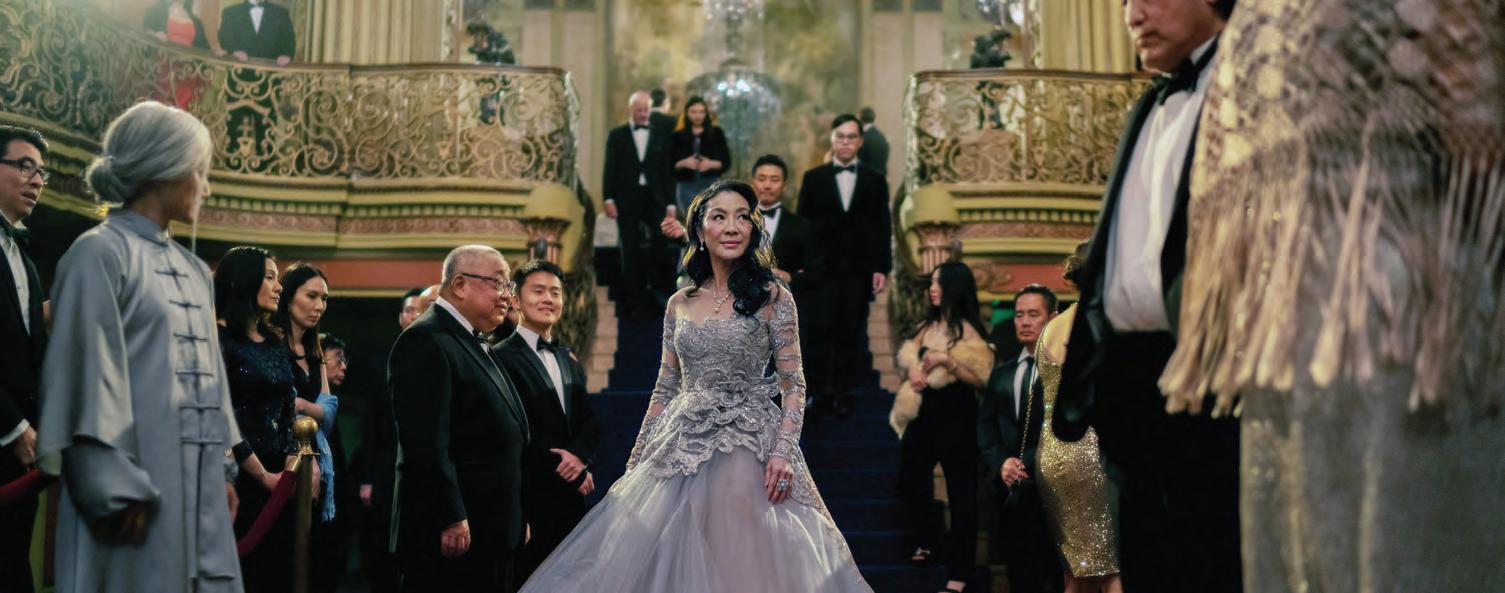
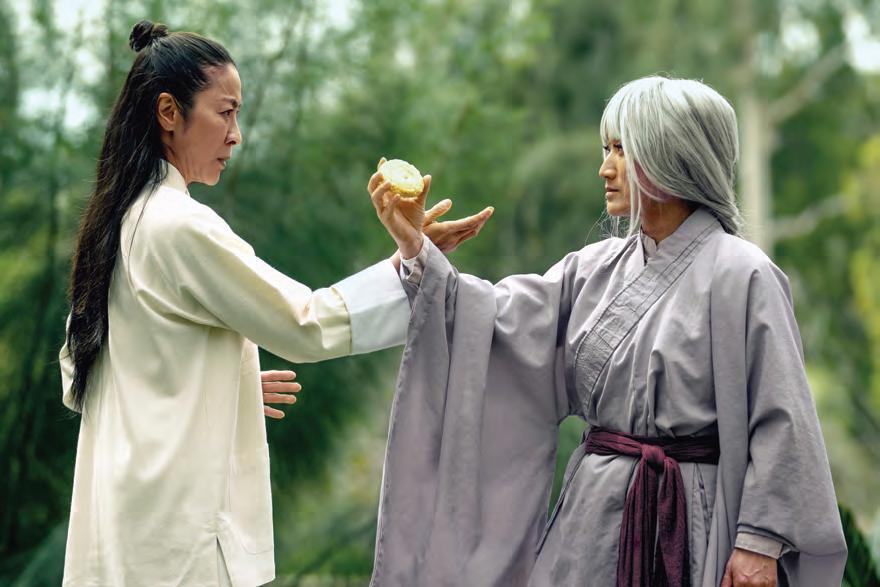
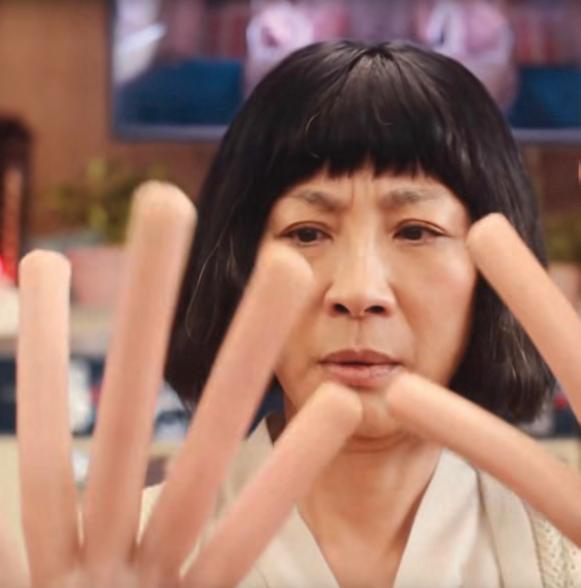
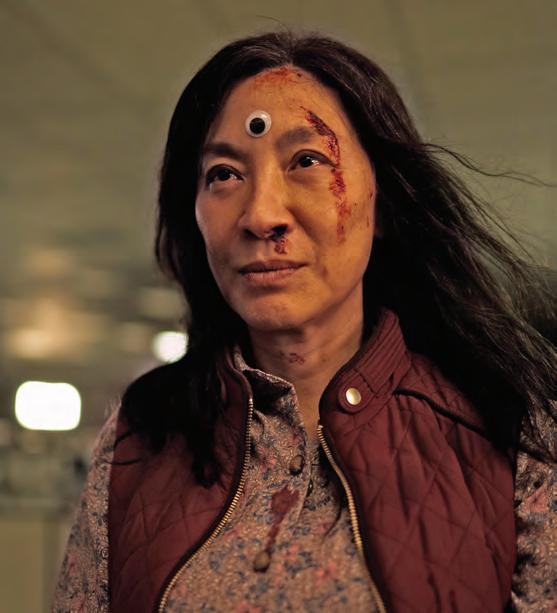

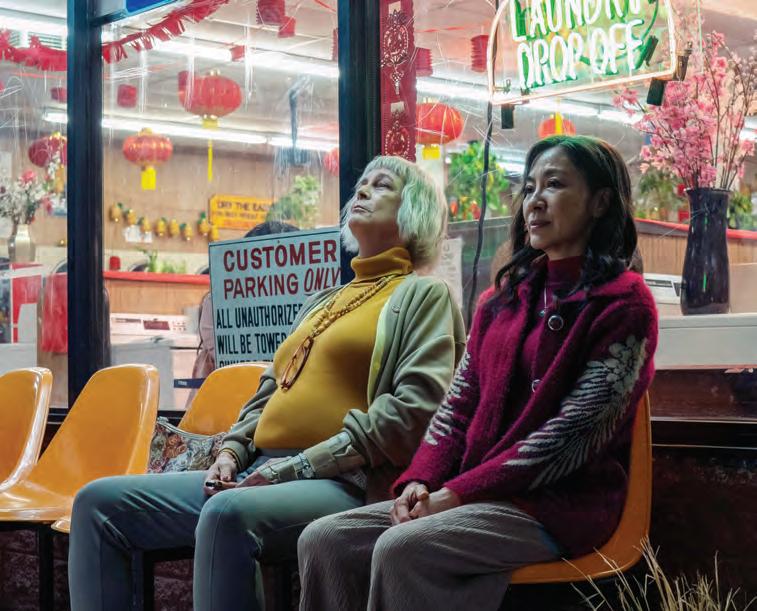
DEADLINE.COM/AWARDSLINE 25




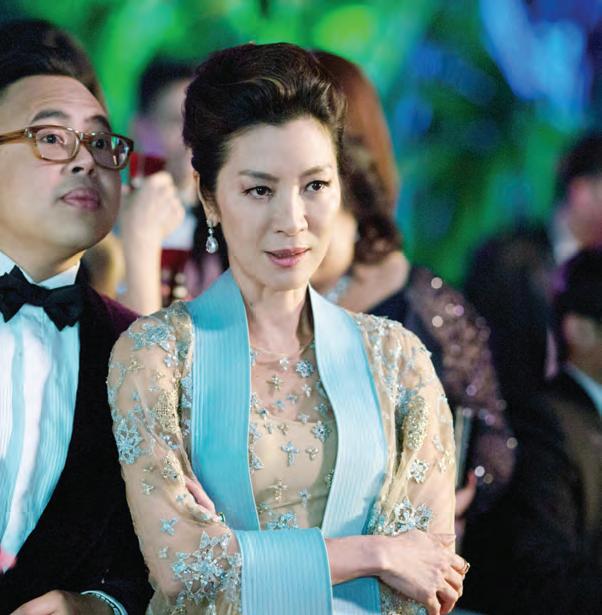
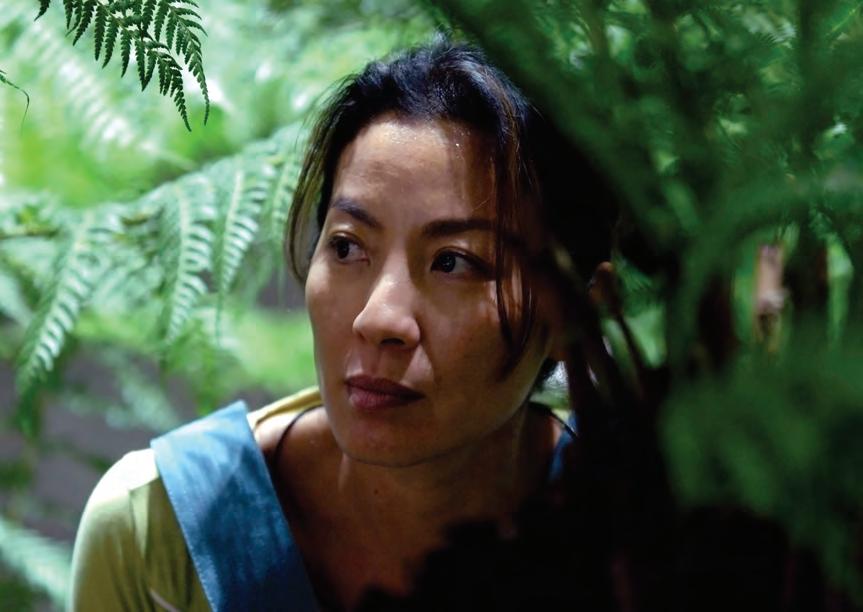
26 DEADLINE.COM/AWARDSLINE
together. We were always running from set to set. So, they lined us up and said, ‘Everyone look to the right, react, then look to the left… OK, now just four of you… OK, now the other three…’” In short, there was very little acting. “They just wanted to cover their asses, basically.”
But it wasn’t as if she knew any other approach. Yeoh recalls re-encountering an actor a few years after they had worked together on her first movie. “You know, your acting has not improved,” he told her.
“I love him for that, because he was right,” Yeoh says. “I watched what he was doing, and I looked at what I was doing, and I agreed with him.” There were dozens of movies, but no time to actually learn “We’d finish shooting a movie on Monday, and it would be in the cinemas by midnight on Friday.”
In any case, when she ruptured an artery shooting Magnificent Warriors—the latest in a series of brutal injuries from stunts that had gone wrong— Yeoh decided she might have had enough of action movies after all. She had started a relationship with Poon, and they soon married. So, still in her mid-20s, and after only a few short years of work, she ‘retired’ from acting. Yeoh had already lived several lives.
retirement lasted as long as the marriage: three and-a-half years. When she returned to the industry, she resolved to act; to figure out what delivering a performance really meant beyond the stunt choreography.
Supercop reunited her with Jackie Chan, and while the stunts were bigger than ever—and the injuries no less seismic—this time there was an established story, and an extant character to play. Yeoh worked hard to build her character a backstory she could embody. “I never could cry on command,” Yeoh says, by way of explaining the approach she came to find, and the one that she still uses today. “You can’t think of something sad—connect it to something in your own life—and use that, because that might work on one take, but it won’t work on the second or third. I learned it was much more important to be emotionally involved in the character I was playing. You have to not take anything from
yourself, but to become the character. To think like her. It takes time. It takes practice. It takes effort. But it is essential for me.”
She was no longer interested in simply showing up to do a job. Clocking in and clocking out. She wanted to be a sponge, seeking advice, and learning from the people around her. She wanted purpose, and the voraciousness to find it didn’t go unnoticed. “Jackie would say to me, ‘You have to stop being so bold, you have to protect yourself and not get hurt,’” she says. “He knew I came back trying hard to prove myself, and he would constantly say, ‘No, wait. Wait for the mattress. Wait for someone to watch your back.’ He took care of me, and I started to look to him; started looking to friends to guide me. I think what’s important is I never was afraid to look at them and say, ‘I know nothing; please teach me.’”
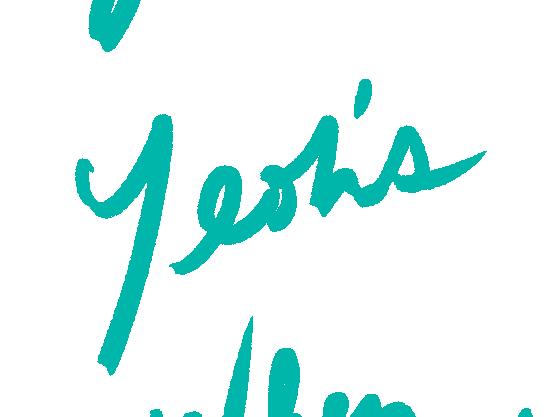
We have witnessed Michelle Yeoh’s film school education ever since. Supercop became a classic of the genre, making enormous waves beyond Hong Kong, and spawning a sequel a year later. At breakneck speed—and she was never so afraid of breaking her neck—Yeoh was honing her true craft, while her natural talent held her aloft.
Her commitment was validated when director Roger Spottiswoode cast Yeoh alongside Pierce Brosnan in Tomorrow Never Dies. She knew the legacy of James Bond and was excited about going toe-to-toe with the character. She told Spottiswoode she would do whatever action or stunt sequence was asked of her. “You’re here on merit as an actress,” Spottiswoode replied. “You’re not here because you can do stunts. In fact, you probably won’t do many of the stunts; we don’t have the insurance for that. We can double you for stunts, but we can’t double you for acting.”
She still remembers the conversation because it offered a kind of validation she had, until then, only received from longtime friends. With it came a confidence to reclaim the name to which she’d been born. When she signed with D & B, the company had insisted she go by Michelle Kahn, a name they deemed more palatable to international audiences than Yeoh. Bond producer Barbara Broccoli told her: “What the fuck? Just go with your fucking name.” She has been Michelle Yeoh ever since.
Her graduating project came in 2000, when she played Yu Shu Lien in Ang Lee’s Oscar-bothering epic, Crouching Tiger, Hidden Dragon. Right at home with the balletic martial arts, Yeoh instead dedicated her time to understanding what drove each of the characters she came across, as well as her own. “The thing with Ang is he hates it when people call me a stuntperson,” Yeoh smiles. “He says, ‘No, she’s an actress. It’s just a bonus that she can do stunts.’”
Sunshine, for example, director Danny Boyle wanted to cast Yeoh as the captain of a space mission sent out to prevent the death of the sun. “I told him I wasn’t ready to be a captain at that point,” she explains. “I told him, ‘It’s interesting you only have one Asian in the whole thing; that you think in the future it’s still the Russians and the Americans.’”
But Yeoh won’t take credit for what she says was an observation, not a pointed criticism. Instead, it’s Boyle and screenwriter Alex Garland she praises for changing their approach. “They were quick to recognize the opportunity, and so we ended up with such a diverse cast. Benedict Wong, Hiroyuki Sanada. What a great experience I had making that.”
It is Jon M. Chu and Kevin Kwan she credits with the success of Crazy Rich Asians, without acknowledging how much her own presence in the film was a blessing for her less established castmates. “It was meant to be a cameo role,” she says, though she took the character no less seriously than any other. “Every time she appeared she made a difference. That relationship with the mother and son—there was only one scene of them together, but it spoke volumes. If that hadn’t come across, the whole thing would have fallen flat on its face.”
“Michelle has always carried this incredible, regal grace to her,” says her Everything Everywhere co-star Stephanie Hsu. “That has been her thing for so long, but what’s amazing having met her is to get to see how truly loving and egoless she is. She was bridging East and West before we were even having these conversations about representation as an industry, and as a society. She has always been the glue that brought people together, just by purely loving what she does. She made people feel seen since before we had the language to talk about what that meant.”
Yeoh’s extensive body of work includes clockwise from top left, Supercop (1992); Crouching Tiger, Hidden Dragon (2000); Sunshine (2007); Tomorrow Never Dies (1997) with Pierce Brosnan; Yes, Madam! (1985) with Cynthia Rothrock, and Crazy Rich Asians (2018) with Nico Santos.
She is buoyed by the film’s re-release in US theaters. “I think Crouching Tiger is such a classic, such a timeless piece,” Yeoh says. “You do need to see it on the big screen.”
The enthusiasm with which Yeoh reviews the many breakings of ground across her body of work is infectious. She talks adoringly of her fans and can point to many examples where her creative choices have influenced the films themselves. On 2007’s
Yeoh remembers running into a mother who had seen Everything Everywhere All at Once. “She told me, ‘I didn’t really understand the movie, but I went to see it because my daughter who has been estranged from me for some time reached out to me after she’d seen this movie.’”
Even in this moment, she won’t take her flowers: “That’s the power of the Daniels. That’s the genius of these two men who wised up and thought, ‘Our mom is a superhero, and we should write it like that.’”
UNITED
ARTISTS/DIMENSION FILMS/FOX SEARCHLIGHT/D & B FILMS/WARNER BROS. PICTURES/SONY PICTURES CLASSICS/EVERETT COLLECTION
“The thing with Ang Lee is he hates it when people call me a stuntperson. He says, ‘No, she’s an actress. It’s just a bonus that she can do stunts.’”
DEADLINE.COM/ AWARDSLINE 27


28 DEADLINE.COM/AWARDSLINE
cried when she read the script Everything Everywhere All at her of the dynamic with her own mother, it felt But it took the Daniels a little time to get it there. to cast Jackie Chan, then re-pair him with Yeoh as a 1990s. When Chan couldn’t commit, they were still came out of left field for an actor better known years ago, and kicked off a wave of aging-action-hero movies that reinvigorated the careers of performers like Sylvester Stallone and Arnold Schwarzenegger.
never had a voice before. Nobody has given her a voice. You walk past her in the supermarket, and you don’t even give her a second glance. She’s someone quite ordinary, but we’re able to turn her into someone extraordinary.”
Hsu says she marveled at the way Yeoh took the Daniels’ high-concept multiverse hopping in stride. “The best word I have for it is she surrendered,” she notes. “She surrendered to me and Ke [Huy Quan, who would ultimately play Waymond Wang]. She surrendered to the Daniels. And I think that comes from her martial arts discipline. There are no celebrities in martial arts. You have to be egoless. You have to work for it, and you’re going to use your body and throw yourself into the fold. That’s the cloth that Michelle is cut from.”
But Yeoh says she understood the material’s deepest reaches. “I think it’s touching because it’s chaotic,” she says. “Life is chaotic. It’s unpredictable. It’s up and down. It’s weird and wild and sometimes you just have to say, ‘Well, OK then.’ Which is what Evelyn has to say to Joy: ‘Just get up and go be yourself. You don’t have to talk to me anymore.’”
“When you write something, you write it with the studios want? What would they react to?’ So, men

So determined were they to work with Yeoh that

She says she saw this moment of revelation most clearly with her own father. “At Chinese New Year, you wish each other bountiful, mega things. That’s the tradition. ‘All your dreams will come true,’ and all that. And, one year, he said to me, ‘I wish you enough.’ At the time I didn’t understand that. ‘What do you mean, enough?’ But when I thought about it, he was saying that regardless of how you think you aren’t living up to expectations, you’re always enough. In any universe.”
Yeoh has always been right about her daughter. She’s 83 now, but she has been a cinephile her entire life, and she was certain Michelle belonged on screen. “My mom loved the whole aspect of performing,” Yeoh says. “Even now, when we throw her a birthday party, it’s like a concert. She’s doing costume changes, getting on stage and serenading everyone. She would have made a great movie star.” But if the path to Yeoh’s first American lead role and first Oscar nomination was tough, for her mother it would have been insurmountable.
When the rigors of ballet started to take their toll on Yeoh’s spine, she instead looked behind the scenes, resolving to open her own dance studio in Malaysia and become a choreographer. With trademark modesty, she describes this simple dream in dismissive terms. “Like how as a kid you might say, ‘I want to be a fireman. I want to be an astronaut.’”
Her mother would stand for none of this shyness. Instead, she signed her daughter up for the Miss Malaysia beauty pageant in 1983—literally forged her signature on the entry form—and needled her into going. Yeoh won, leading to an appearance at Miss World, and the attention of D & B Films who cast her in the commercial that changed her life path forever. She knows now that this was absolutely the right road for her to walk, and that her mother saw something she couldn’t—or wouldn’t—at the time.
In retrospect, then, there’s a direct line between that instance of maternal document fraud and Yeoh’s Oscar nomination, which is the first Best Actress nod for a Southeast Asian woman who was able to be open about her heritage. In 1935, Sri Lankan-Māori actress Merle Oberon became the first Asian woman ever nominated for the award, but she spent her entire career claiming to have been born in Australia, so afraid was she of what might happen if she were honest about her heritage.
As Yeoh reflects on her career, she recognizes the long, winding path she’s had to forge to get to Everything Everywhere All at Once. She knows now that her future in dance would have been far from certain even if she hadn’t hurt her back. After all, there were no Asian faces in the Royal Ballet at the time she graduated. And for the longest time, she wasn’t sure Oscar interest would ever come to her, or to any of her peers. “Look at Crouching Tiger, look at Parasite and Minari,” she says. “Even though they’re being recognized as great films, none of the actors or actresses were ever mentioned. It was like people looked at the color of your skin to determine whether you were white enough to qualify.”
She hopes her nomination, which she shares with Quan and Hsu in the supporting categories (co-star Jamie Lee Curtis is also recognized), is an indication that things are changing for Asian actors. “But we have to keep at it. We mustn’t take our foot off the pedal.”
Whether or not she’ll admit it, Michelle Yeoh knows the need to fight for herself, on- and off-screen. But, much as it is for her mother, sometimes it’s easier for her to urge others to fight for themselves. Indeed, when this reporter makes an offhand comment about his own insecurities, she fixes a look that instantly recalls Evelyn Wang and says—sternly—no. “We’re here because we’ve worked our asses off to be here,” she insists. “We have paid our dues. We have done whatever it took. We found ways and means to get better, so that we could be seen, and so that we could improve. That’s why we’re here.” ★
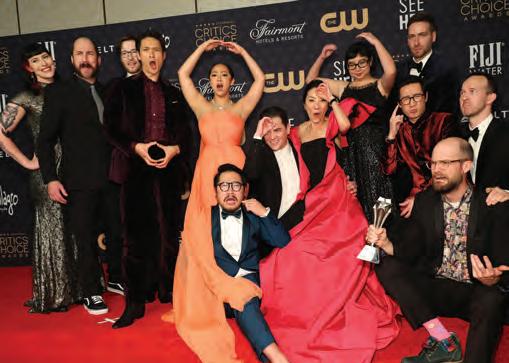
“We’re here because we worked our asses off. We have paid our dues. We have done whatever it took. We found ways and means to get better, so that we could be seen, and so that we could improve.”
DEADLINE.COM/ AWARDSLINE 29
Everyone Everything Everwhere , from left: Kelsi Ephraim, Jason Kisvarday, Zak Stoltz, Harry Shum Jr., Stephanie Hsu, Daniel Kwan, Jonathan Wang, Michelle Yeoh, Shirley Kurata, Paul Rogers, Ke Huy Quan, Daniel Scheinert and Jon Read.
Angela BASSETT
Digging into “the meat, the marrow” for her role as Queen Ramonda in Black Panther: Wakanda Forever
BY CARITA RIZZO
Thirty years after her first Oscar nomination for her portrayal of Tina Turner in What’s Love Got to Do With It, Angela Bassett is once again a contender. But this nod, for her heart-wrenching turn in Black Panther: Wakanda Forever, feels different. “I was just shell-shocked last time,” Bassett says. “It’s still very exciting. But last time, it was just mind-blowing.” Her second nomination is no less meaningful— it's the first performance in a Marvel movie to be recognized by the Academy. Bassett talks about the historical and emotional nature of Wakanda Forever and finding the marrow in everything she does.

Your Oscar nomination for Wakanda Forever is history-making. What kind of significance does that have for you?
I haven’t really concentrated on that, but I’m appreciative of being a first. Other than breaking that glass ceiling, I’ve never been a first before. It was a wonderful effort with wonderful creatives and filmmakers and, at the helm, Ryan [Coogler]. I’m just pleased and proud to be a part of a franchise, a movie, and a universe that is doing some great work and has been very successful.
Re-watching the film, those first scenes are so impactful. It's hard to imagine that the grief portrayed is much different from what you, as a cast, felt outside of the film.
Onscreen, what was it like to say goodbye to Chadwick (Boseman, who passed away in 2020 from colon cancer)?
I think it went quite a long way in terms of the healing of saying farewell for now. A lot of us were in various places and couldn’t come together [when Boseman died]. We had built a family, and he had so expertly, and beautifully, led the way in the first Panther. It was very, very moving to each and every one of us to come together as a family and be able to tell this story, to pay homage and honor him in our way, in the way that we can as actors and filmmakers. It was beautiful. Calm and peace came over us. We were all going to put forth the full measure of our devotion for him in the making of this movie.
Then, of course, the show has to go on. You say goodbye to a character, and the film has to tell another story. How was that transition for you?
You’re right. Life does have to go on. I guess that’s the nature and the glory of life. It does carry on. We expressed that with Shuri (Letitia Wright) coming into her own and the meeting of T’Challa’s son. It’s just ever hopeful. I think we definitely tried to impart the feeling of, ‘A good morning comes after a long, dark night.’
In the film, you have a scene where you fear that you’ve lost both of your children. It plays out in front of a lot of people, but it feels like it’s between you and Danai Gurira’s character, Okoye. What do you recall about shooting that scene?
I remember being surrounded by all the other players, by the council, by the Dora Milaje, by the Jabari tribe and by the elders. I remember that glorious room. I remember rising
30 DEADLINE.COM/ AWARDSLINE DEADLINE PORTRAIT STUDIO/WALT DISNEY/EVERETT COLLECTION
★ ★ ★
★ ★
from the throne and addressing her, being filled with such grief and sadness and righteous indignation and all those things—just emotions. Just being in the moment and being so pleased to be in the moment. Like you said, it felt very intimate between Danai and I, a real conversation, an understanding that had to be made known. She’s making hers known and I’m making my mine known. Yeah, I remember tears. I remember it all.
If I had told you prior to Black Panther that there was a Marvel film that would offer you this type of material, would you believe me? Well, anything is possible if you believe, and I’m a believer.
Did you have to be convinced that there is a meatier aspect to franchise films?
Oh, no, no. I’m always going to look for the nourishment. I’m going to look for the meat, the marrow.
I imagine that Ryan Coogler has much to do with that. What’s unique about working with him as a director?
Oh, he’s such a comprehensive storyteller. He understands story, structure and character, intention, subtext and collaboration. There’s something about him where everyone shows up and wants to—and will—give their best effort. He’s just so respectful and honors what you do in your particular lane. He was the real deal in every aspect and respect.
Do you recall those conversations where you two collaborated to open up the character even more? There were many. He has stories like, “Can you apply this moment from real life with a mother and a daughter? Or a mother and a child?” Or, “Do you remember when?” He has all these memories that he will share with you. They’re so unique and helpful. I said, “No, I never thought about it that way.” He just has such an emotional intelligence.
You have sat in this character now for a while. Was there a scene in
this film that gave you an even better understanding of Ramonda?
I love those scenes with Shuri, whether it’s out in the wilderness or in her laboratory, where she’s interested in what her daughter does, but also, taking her away from her blanket of comfort—that lab and her intelligence—and trying to get her to settle into the heart of who she is, just for a moment. It may be painful, but it comes to pass. It won’t always remain. It will come to pass, but you have to be open and warm. I enjoy that.
As a mother, is that something you relate to, opening your children up to the world?
Absolutely. It’s important to preserve yourself and your energy. It’s important to protect yourself, your mind, your heart, but it’s important not to be rigid and immovable as well. It’s a balance. It must be struck.
I get the sense that this film feels very personal, and there’s a lot to draw from real life.
Much has been said, and it’s true, there’s a story here that is led by women—and by Black women, by and large. I think we are a very strong, resolute tribe, so I’m very proud of that and just proud of what we’re able to do onscreen and proud of the impact that we’ve had with audiences. It’s an honor when the movies you make, the entertainment you give, is also helpful to the lives of some. This movie was about grief and loss, family, a remembrance, a legacy and moving on. That’s something that’s so very human. To actually connect with audience members who have gone through some of this,
and it being a source of comfort and conversation for them and their families, that really is quite an honor that you’re not expecting. But it’s an unexpected benefit and blessing.
There’s been a huge cultural impact in having five women lead a film like Black Panther. There has to be an impact behind the scenes as well. What is it like to surround each other with this level of talent and support?
It was nice to come back again for it and carry on the journey of Black Panther. You feel like a family. That familiarity is a beautiful, comforting thought and experience. It’s great to see each other shine and to watch each other shine.
You’ve experienced this before with Waiting to Exhale, American Horror Story…
Gunpowder Milkshake, where we were assassins, Michelle Yeoh and I. Yes, I’ve been very fortunate to show the world that we’re bad; we’re awesome and amazing.
Is the Wakanda Forever experience different from being the sole female lead on a film?
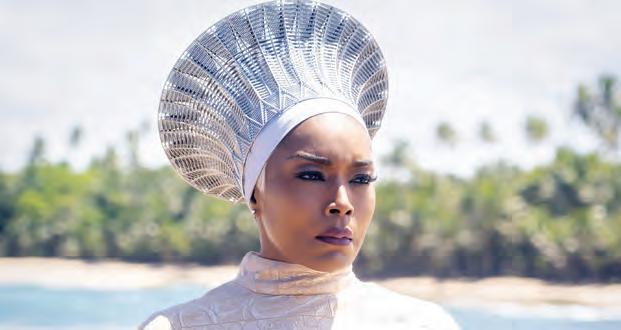
Yes, the sisterhood is beautiful. It’s very, very supportive—you have your cheering section. You’re cheering each other on. You can feel the support, most definitely.
Let’s talk about the physical challenges of a film like Black Panther. What were those underwater scenes like?
It was deep, but at least it was warm. That’s the one thing that you
appreciate [laughs]. They kept it at a nice, warm bath temperature. But it was deep and would’ve been a bit daunting and scary had we not had the freediving instruction to be able to learn to hold our breath for as long as the take entails, and the swim lessons. I appreciate that because that was not my forte. I hadn’t been in the water in an awful long time, since I was in, I don’t know, third grade or something. I could do one little doggy paddle, you know.
It looks so impressive. Are you always that physically fit?
No. No. No, it ebbs and flows to this thing called life. I try not to get too far out of pocket; maybe a month or two and you’re back to your fighting weight. I enjoy it. It’s a challenge. I’m happy at this stage of the game to be called upon to do any manner of stunt.
With Black Panther, is there a challenge unique to these films that maybe isn’t physical? To craft, to draw, to act in and be in this world together, this world of Wakanda... It’s an understanding beyond the words in the subtext of the script. I lay that in the hands of Ryan Coogler and his vision to get us all, literally, on the same page of something that we’ve never seen before. To get us on the same page emotionally, spiritually, physically—I think that’s pretty daunting.
I read that you pushed back against your character’s death. Was that because you’d like to join the gang again, or was there another reason?
Of course, I love being queen. Who doesn’t? I adore and appreciate this character. I didn’t push very hard because I’m ultimately there to serve the vision of the filmmaker, but I was shocked when I saw how he drew me. I was shocked. I was surprised, but I trust him wholeheartedly. I think I got over it pretty soon.
Isn’t it your character that says that there’s another plane? Right, we said, “He’s dead, but it doesn’t mean he’s gone.”
DEADLINE.COM/ AWARDSLINE 31
★
As Queen Ramonda in Black Panther: Wakanda Forever .
Judd HIRSCH
How the scene-stealing star of Meet the Fabelmans got carte blanche from the world’s most famous director
BY DAMON WISE
“All I wanted to do this morning was get up and bake a pie,” says Judd Hirsch. Sadly, the 87-year-old actor’s plans to make his specialty— apple and blueberry—on a day off from ABC’s The Goldbergs have been interrupted by publicity duties for The Fabelmans. In Spielberg’s not-so-veiled memoir about his teenage years, Hirsch stands out as Uncle Boris, a distant relative who barges in, like the ghost of Christmas Past, while Sammy and his family are mourning their late grandmother. His youthful enthusiasm makes it hard to believe that, if the gods smile on him, Hirsch will become the oldest ever Best Supporting Actor winner.

Where are you calling me from? New York?
I’m in Los Angeles.
So you’re on the campaign trail?
More or less, I guess. I mean, there’s a train that’s leaving every day, and I get on it.
How do you feel about that?
You’ve been nominated before, and you’ve won a lot of other awards. Does it still have the same appeal for you?
Well, because it takes so long after the film comes out before anybody says anything about that, it’s almost like three and-a-half months before you get to the point where you’re in some sort of contest. And for that length of time, it seems like the light
on it sort of fades. You go, “Wait a minute…. Oh yeah, I remember that movie!” And then it goes on and on and on. The public—everybody—has a very short memory after you’ve done something, especially movies. You do them, they see them, goodbye. You know what I’m saying? So, in effect, winning one of these awards is really about the moment when you win the award and whoever else was around when you did it.
It happened to me back in 1981. Everything was new back then. I don’t think I remember there being that much press attention. At that time, I was nominated in the supporting actor category for Ordinary People, along with the kid who was actually the lead in the picture,
32 DEADLINE.COM/ AWARDSLINE
MICHAEL KOVAC/GETTY IMAGES FOR AARP/UNIVERSAL PICTURES/EVERETT COLLECTION
★ ★ ★ ★ ★
Timothy Hutton. And there was nothing to enjoy about it because I could only wish to lose, because he didn’t belong in my category. And since he was, it would’ve been absolutely unfair to him if I won. I mean, I would have had to explain that to him forever, and he was only 19! Everybody knew that if you were in the leading man category, you were probably going to lose to Robert De Niro that year [for Raging Bull]. So, I’ve never had a moment when I’ve gotten into one of these things where I can actually cheer for myself. Maybe this is one of them.
Let’s hope so! How did this role come to you?
Well, I don’t know. It came in sort of like a balloon, like these balloons the Chinese fly. [Laughs] You don’t know where they came from, but, boy, do you know when they’re there! The only thing I got from my agent was that somebody by the name of “S.S.” wanted to see me on a Zoom. And I thought, Well, that’s like a mystery. And my agent said something like, “It might be Steven Spielberg.” I don’t know why he didn’t know either.
So, I said, “OK, give me the Zoom [details].” And then of course, I forgot. I mean, I was still in the house. And then all of a sudden, maybe about, I don’t know, 20, 30 minutes later, I went, “Oh crap, I got this thing.” So, I get on the Zoom, and there’s Mr. Spielberg twiddling his thumbs, waiting. And the only thing I had to say was to identify him to himself. I said, “You’re Steven Spielberg.”
I’m not usually a nervous person, but I was then. After that it was a very simple conversation. I was saying, “What do you want of me?” And he was saying, “I have a character in a movie that I’m doing about myself.” I said, “Really?” He said, “Yes. It’s a great uncle of mine.” And I said, “Well, where does he come from?” He said, “I don’t know, but I think it might be the Ukraine.” I said, “OK. How long ago?” He said, “Well, it’s a long time ago. He’s old.” And I said, “What did he sound like?” And
he said, “We kind of hardly understood a word he said.”
So, that’s about as much as I got to play this part. From one of the greatest directors of all time, that’s the information he was able to give me. He said, “Well, read the script. The script will be coming to you momentarily. Read it and give it back.” So, I read the script, and I’m looking at this character that he’s talking about, and I’m thinking, ‘This is not somebody that’s an understandable human being.’
Later on, I found out that everybody who was in the film was given all kinds of relatable things to their characters. I mean, like pictures and photographs, and maybe even motion pictures and pieces of clothing. They were completely filled out with [information about] Steven’s family. And for me there was nothing at all. Nobody ever sent me anything. And I thought, ‘OK, well, it looks like we’re going to have to make this guy up.’ Now, remember that it’s a real guy. I mean, I was promised that this man is real, so I thought, ‘Well, if he’s real, someone’s going to give me a hint somewhere down the line: Well, he was kind of like this, or, he looked like that…’ But, no. I was there to fill in. And by the way, my character has the only real name in the movie. Everybody else has a fictional name. You know what I’m saying?
Seriously?
Yes. Uncle Boris is the only actual, real name. So, that set me back. I’m behind the eight ball here. I just can’t
get any information, no matter how much I ask. I mean, I even ask Tony Kushner, because he’s written this, oh, I don’t know, seven-page monologue. The big question is: why did he come? What’s he doing there? What’s his intent? And why is his intent so intensive? I mean, it’s like, who asked you? Who invited you?

How did you find an answer to those questions?
I had to look at it as if it was something from Steven’s very young memory. Not from the point of view of Spielberg remembering it now, but going back to a time when he was actually 17 years old and trying to remember it as he might
remember it then, or as he felt about it then. And that’s the point of view, the real point of view. And if you take it that way, then you could say that the exaggeration in any way is because of a young mind. So, guess what? I could play it the way I wanted to: I could play the dramatic, almost fictional idea of this man. And I had to do it right on the spot. There was no preparation. You can’t prepare for something like that, which I thought was exciting.
This is the only time I’ve ever been asked to do something like this in my career. And I thought, ‘OK, all right. The invitation is out. Show up, Judd, show up.’ And that’s all I did. We never rehearsed anything. I’d never even met the kid before, Gabriel LaBelle. We just looked in each other’s eyes, and we started. And we never stopped.
What was your way to get into into the character?
I said to myself, ‘The character is there to try to figure a few things out for himself, because he’s already coming with [a lot of questions].’ He’s coming because his sister has died, and he’s come to mourn her. And that’s Steven’s grandmother, OK? But the scene is not set up to be a mourning—that only happens at the very end of the scene—so that’s dramatically interesting. That’ll get any actor to jump in and simply start from the beginning and see how far it goes. I was actually afraid that I was going to be a little bit on the dangerous side. Well, never mind a little bit, a lot
To a younger man, someone like Uncle Boris can be very intimidating. And you capture that very well.
Right. Right. But you see, I didn’t know that. I asked the master, “Is that really what happened?” And here’s his reaction: he smiled. I think he saw the humor under it, which I think is the great relief of the scene, and I think that’s what Steven really wanted. Maybe that’s why he wanted me in this. [Laughs] Oh, I don’t know. There’s always humor in drama, as far as I can see… ★
DEADLINE.COM/ AWARDSLINE 33
I get on the Zoom and there's Mr. Spielberg twiddling his thumbs, waiting. And the only thing I had to say was, “You're Steven Spielberg.”
From left, Gabriel LaBelle and Judd Hirsch in Meet the Fabelmans
Lukas DHONT
 BY DAMON WISE
BY DAMON WISE
From the moment it premiered in Cannes, where it won the Grand Prize, Lukas Dhont’s Close became a hot bet in the International Oscar race. Following his 2018 debut Girl, which focused on an transgender ballet dancer, Close is another poignant snapshot of youth, this time telling the story of a pre-teen boy and the guilt he feels when he grows apart from his emotionally troubled best friend. At just 31, the charismatic Belgian director is already a festival veteran and European arthouse poster boy; it seems to be only a matter of time before he breaks out into the world of commercial cinema.
When did you first develop the idea for Close? Was it straight after Girl?
When I went back to writing, after the whole journey of the first film, I realized that I wanted to make a companion piece to it, in the sense that Girl was so much about femininity and I really wanted to make something about masculinity. I
had this realization about myself: when I was young, from very early on, I started to push friends away, because I started to become fearful of intimacy. And when I started investigating that idea, I realized that that was something in this very dominant masculine culture of ours where we often value independence and competitiveness. Authentic
34 DEADLINE.COM/ AWARDSLINE JEFF SPICER/GETTY IMAGES/A24/EVERETT COLLECTION
The director ponders the fragility of life and how masculine culture leads to an “epidemic of loneliness”
★ ★ ★ ★ ★
connections between young men are not nourished as much as we should nourish them. We tell young men to stop listening to their heart, to stop listening to what they actually desire, and so we create this epidemic of loneliness.
You said you found a book on the subject, called Deep Secrets. How did that help you translate your idea into something real?
That book was really important because it showed me that this dynamic I was thinking about, this pushing away, is a universal experience. I mean, 150 boys were interviewed for that book, between the age of 13 and 18, and we see with nearly all of them how those years impact them: they start to distance themselves from other boys, even if only a little bit. It showed me that what I thought was personal wasn’t personal, and that’s an important step in my writing process. Because although I always start from a place that is deeply felt by me, I want to leave myself behind very early on. I’m looking for a way to express my feelings so universally that they can be felt by many people. I strongly believe in the sense of collective catharsis, so I look for the places we’ve all been. For example, we’ve all been heartbroken by friendship. We’ve all been pushed away. We’ve all pushed people away. It’s something that takes us over and so often slows us down.
What do you do when you’ve found your subject?
I then try to incorporate something concrete. In Close, the concrete form became this young friendship—a friendship between two boys that is sensual, that is intimate. It’s not about their sexualities, because usually we only get these images offered when it is going to be about their sexualities. For this story, I also realized that it needed to be about mental health, and about the invisible enemies—the made-up enemies, not the real ones—that we face when we lose touch with ourselves. And so suicide became a part of the narrative,
because this moment in time is also the moment when the suicide rate [for young men] goes up a lot: four times compared to that of women.
The main character lives on a flower farm. Why did you choose that location, and why was it important to you?
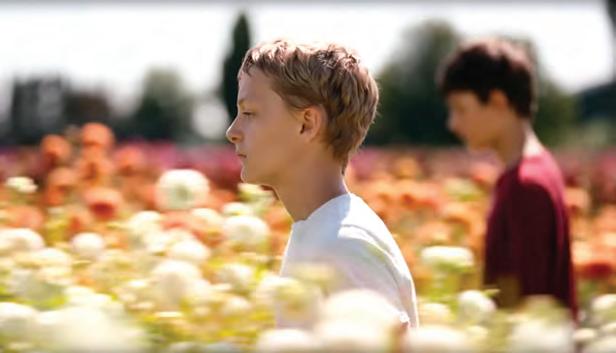
One of the very first images that came to my mind was the image of two boys running through a field of colorful flowers. I think, unconsciously, my mind went there because it’s an image I have in my mind from my younger days. I grew up in the Flemish countryside, very close to a flower farm. And when I started to dissect the image, and look more closely at it, I thought it offered many things. First of all, the film starts with the boys playing in a bunker, a place that we so often link to masculinity, a place associated with enemies, soldiers. And all of a sudden, they run out of that bunker and into this colored flower field. It’s the complete opposite of what we have just seen, the flowers, the fragility, the tenderness. And so I think that it immediately, from the beginning, sets out what this film is going to be about. I think also the flowers stand for the fragility of life, because I knew when I was writing it that the passing of time would become very important. And these flower fields allowed us to show it in an organic way.
Why were you so drawn to telling these stories?
Well, I think it is important to show a young [person’s] perspective of the
world. When we are adults, we come to understand just how impactful our younger days are. But when we’re young, we are not always aware just how much is shaped and how much is created for us at that moment in time. It’s our first confrontation with a society that has all these expectations and codes and norms that we all have to live up to, and that, for many of us, creates this big source of conflict. At least, for me they did.
How do you feel about Girl now?
I haven’t re-watched the film recently. Maybe I will sometime soon, I don’t know. It was an incredibly beautiful, overwhelming first experience. The first time is always special, as we all know, in many ways. And I think it’s a very dear film to us. And after traveling the world with it, I think we really had to let go and start a new one.
Did you have any kind of nervousness about returning to Cannes with Close, making it into the competition selection with only your second film?
Oh my God, of course. Of course! I think I was much more insecure writing and making my second film than I was making my first one. I feel like with the first one, you do not have the context. You’ve never been to a big festival. You haven’t premiered a feature. So I think with the second one, I was much more aware of everything. I was much more looking at myself from an outside perspective. And it really took me some time to go back to my heart and soul to decide what it
was that I really wanted to make as a second piece. As someone who, from a very young age, was very vulnerable to the idea of wanting to please others, it took me some time to really let go of looking at myself from an outside perspective.
So what’s next for you?
After the Oscars I’m going back home, and [my producer and I are] going to really reconnect to what our desires are, how we feel we should continue, and what piece that we’re going to do that with. And we have some ideas, which is great, but we’re going to take some time to really explore them and look around and take the time to really know what we’re going to spend the next four years of our lives with.
Is that how long it takes you, for each project?
I mean, it’s the years that it’s taken now. Maybe it goes faster, maybe it goes slower, I don’t know. But until now it’s what it took.
Is there anyone you want to work with? The great gift of awards season is that you get to travel and meet incredible people…
I’d love to write with Céline Sciamma. I’d love to work with Colin Farrell, and I’d love to work with Michelle Yeoh.
That’s a good list right there. Have you had any approaches from the U.K. or America to work in the English language?
Yes. This moment in time also gives me the opportunity to investigate other contexts, and other places and scripts, and I am investigating that a little bit. For me, the main importance is that when I make something, it starts from a place of passion and it starts from feeling really, really excited about something, and if that happens, then it can be in any given [place] or any given context. So I’m open to whatever comes my way. I’ve read some beautiful things, and I’ve met some beautiful people. But like I said, I really need some time to figure out what it is that I want to do. ★
DEADLINE.COM/ AWARDSLINE 35
From left, Eden Dambrine and Gustav De Waele in Close.
Domee SHI
The writer-director saw herself in the teen characters created for Turning Red
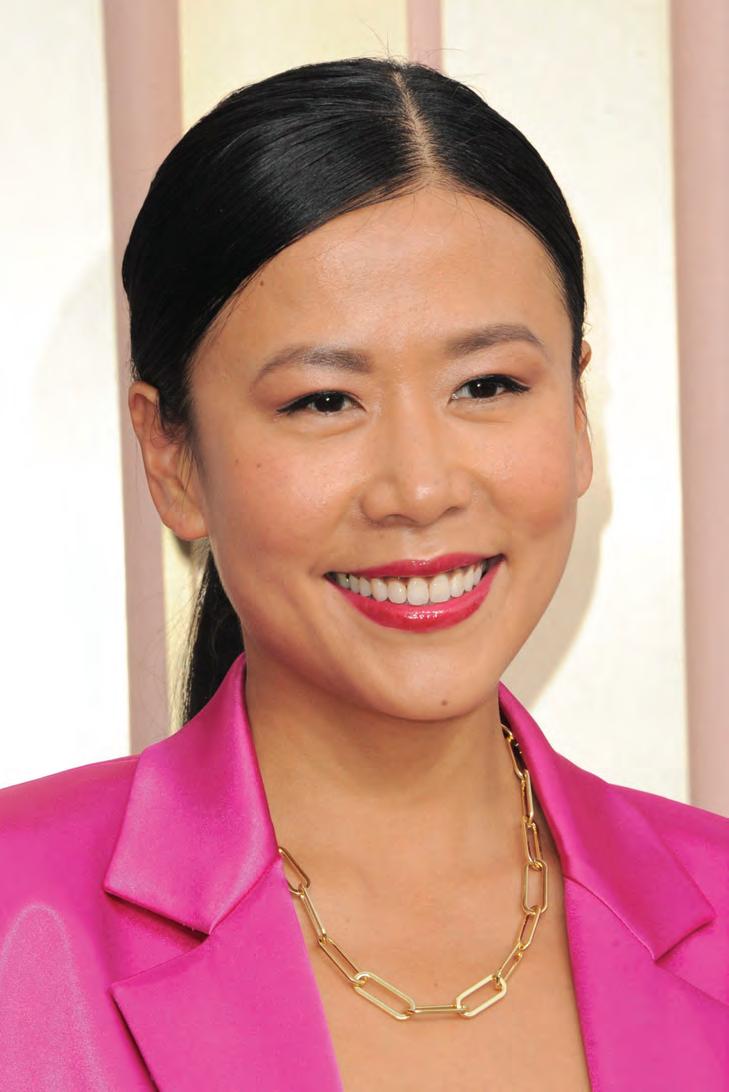 BY RYAN FLEMING
BY RYAN FLEMING
After bringing home an Oscar in 2019 for her animated short Bao, Domee Shi returned to her well of childhood experiences for Turning Red. Due to a family blessing/curse, 13-year-old Chinese Canadian Meilin (Rosalie Chang) transforms into a red panda whenever she experiences strong emotions, which is less than ideal for a teenager. Using Mei as a surrogate character, Shi replicates her childhood experience of struggling to please her mother as she entered adolescence. The film’s portrayal of the mother-daughter relationship sparked dialogues between teens and parents going through the same experience and gave Shi a chance to become closer with her own mother.
When we spoke on nomination day, you mentioned what this nomination meant to the Asian community. Can you expand on that?
This film is one of the first, if not the first film, at least from Pixar, that really shines a light on and highlights the Chinese Canadian community. The protagonist is this Chinese girl struggling with this very specific yet universal issue of her mom being super protective. It’s so important and amazing to see that this film, that is so specific and has such a specific protagonist in such a specific setting, has been embraced globally. Just seeing the commercial and critical success of this movie, hopefully, shows other studios that universal stories can be told by people of different ethnicities and cultural backgrounds.
I also feel like it’s just amazing seeing the reaction to our film from the Asian community as well. I have a lot of fans write me letters, like an Asian teen girl who’s dealing with the exact same thing with their mom and trying to be perfect, and this movie really helped them accept that they get Bs and Cs, and how the relationship with their mom will be the same. It’s heartbreaking, but amazing to hear that our film is a source of healing and joy for the community.
Some people think if a film is about a specific community, it’s only relevant to that community, but this film has many universal themes. Yeah, and there’s been so many culturally specific movies in the past that have resonated with a wider audience. It’s just that the cast members happen to be of Caucasian ethnicity. I grew up watching films and TV shows with characters that didn’t look like me, but I could still identify with them and care about them because of the storytelling. I saw myself in what they wanted and what their struggles were and how they overcame obstacles, and I think that’s why we go to movies.
Has this film had the same impact on your own family?
I like to think that instead of going to therapy, I made this movie. I
definitely think it brought me closer with my parents, especially my mom. I remember when she first watched the movie at the Toronto premiere of Turning Red, and I invited both my parents. My dad wears his heart more on his sleeve, so, he’s a very reactive, emotional guy, and he cried, and he was like, “Oh my gosh, I loved it. It was so beautiful. I’m so proud of you.” And my mom was a little bit more held back, a little bit more reserved, and she was like, “Yeah, yeah, it was amazing. It was great.” But she kind of kept it at that.
I wondered what she really thought, and then a day later, she sent me this huge block of text detailing every single thing she loved about the movie, and I was so surprised that she paid so much attention to certain details. It just showed that she really did absorb it all, and it just took her a minute to process her feelings, and then that whole block of text gushing about the movie ended with, “I hope I was a good mother,” and I was like, “Oh my God, I’m crying,” and she’s like, “Me too.” So, it was a delayed kind of reaction, and it was funny because it was all through text, but it just felt like 33 years led up to this moment.
Speaking of relatable themes, this film really showcases that teenage craziness where every situation is life and death, even just going to a 4*Town concert.
The idea for the concert came pretty early on, though it wasn’t in the very first version of the story. It was an even nerdier and weirder goal, which was that Mei wanted to go to this artsy boarding school in California, and the only way to do that, in her mind, was to direct, write and produce a musical about the origin of her favorite boy band, 4*Town. She was working towards putting on this musical, and then we thought about it, and we felt it was a little complicated because it’s too many steps. It would be simpler and more teenager-y if her goal was just to get to a boy band concert.
That came in the second draft of the movie, and we just leaned into who our main character was. We
36 DEADLINE.COM/ AWARDSLINE ELIZABETH GOODENOUGH/EVERETT COLLECTION/WALT DISNEY
CO.
★ ★ ★ ★ ★
loved the specificity of that drive, that goal to get to a boy band concert, and I think all of us on the crew leaned into our 13-year-old selves, and we remembered that everything was life and death. How do we dramatize this goal to make the audience feel that way too? It was a really fun challenge, and it just felt so unique to our movie. And then it was really exciting for me personally, too, because I never got to go to that boy band concert as a kid because my parents didn’t let me go, so it was a little bit of wish fulfillment on my part as well.
Did you try to make a musical about their origins to show your parents that you should go? No, I should have. I should have made a PowerPoint. I should have done all of that.
We’ve talked about you being the inspiration for Mei. What were the inspirations for her friend group? They were all inspired by friends that I’ve had growing up. Miriam is that goofy, rebellious friend who pushes you out of your comfort zone. I definitely had a friend like that. My mom didn’t 100 percent approve of it because she’d be like, “What did your friend get on her report card?” She’d be all suspicious and ask if you should be hanging out with someone who’s maybe bringing down your grades to a B. Abby was directly inspired by my friend, who is the voice actress for Abby, Hyein Park. She and I went to animation school together, and we were roommates at one point, and it’s just who she is. She’s just this very passionate, loud, fiery being in a tiny package, and I just loved that about her, that she is your ride-or-die, and she will get angry for you in scenarios and be your biggest defender.
I also thought it was important to show Mei had other Asian friends, too, so it wasn’t just her, and that’s why we also added Priya as well because there’s a large South Asian population in Toronto, and I grew up around a lot of South Asian kids. Also, she represented kids with a vampire phase or a gothy, witchy phase in high school or middle
school. I was really into Buffy for a while and Interview With the Vampire, so I definitely had that phase. I thought it’d be really fun to give Priya those characteristics, and it lifted the burden off of Mei, too, so we could push her personality to make her a perfectionist, a mama’s girl, without the danger of saying that this is how all Asian girls are. That was the intention behind the friend group, because we wanted them to feel like these different representations of being a girl, but we also wanted to show them being super supportive of Mei. I feel like I don’t see that specific girl friendship in movies or TV shows a lot. So it was a really cool opportunity to be able to share that, to get a window into what it’s like to be a teen girl in those groups and how they act and behave.
Then you also had Tyler, the bully, who changes throughout the film. We redeem him or at least show another side of him. Tyler’s character evolved a lot through the production of the movie. In the first draft, the one where Mei wants to put on a 4*Town musical, he was another character completely. He was her cousin, and his name was Leo. He also turned into a red panda as well, and we were exploring this idea that he would represent male puberty, and the ups and downs and struggles of that. But then we felt like that was competing with and overshadowing Mei’s story. It was moving away from the initial idea of this story, which was this girl going through magical puberty, and her
relationship with her mom was the most integral part of the movie. So, we stripped down his character and simplified him a lot more. We turned him into the class bully, and then I think in talking with a lot of my male colleagues and friends, a lot of them confessed that they were also huge Backstreet Boys and *NSYNC fans growing up, but they never admitted it because they were just afraid of being judged. And I was like, no, that’s awesome. Boys should be proud, and they should be proud of the music and the musicians that they like. So, we gave that story to Tyler just as a shout-out to all the boys out there who secretly love boy bands too. It’s OK, it shouldn’t be a secret. Be out and proud about it.
It also shows that many of our fears of being rejected and unaccepted are just in our heads, and you will never regret being your authentic self because it brings people closer to you. Mei became closer with her friends, and Tyler found a new friend group. So hopefully, it encourages that in audiences when they watch the movie too.

Did you have the idea of transforming into the red panda from the beginning?
Yeah, because I was really inspired by a lot of things. I really wanted to do a coming-of-age story, and I felt like there were a lot of coming-of-age stories in the past about boys transforming, like Teen Wolf for example, or there was this Disney TV movie called The Thirteenth Year where this boy transforms into a mermaid. There’s
a whole bunch of these fun, cheesy coming-of-age TV movies that came out when I was that age about these different teens. There was one called Luck of the Irish, where this boy finds out he’s a leprechaun, and I thought it would be fun to do my own take on that. And the idea of a red panda just popped into my head because they’re just so cute and unusual looking, and they’re red and hairy, and I hadn’t seen a movie really explore or showcase the cuteness of a red panda. So, I thought that would be the perfect metaphor for this girl going through puberty. That was my initial intention with the idea.
I also watched a lot of anime growing up as well, where there was a lot of magical transformation in it. Ranma ½ was a big inspiration for me, which is this high school romcom anime about this boy who fell into a cursed pond, and every time water is poured on him, he turns into a girl, and then he turns back into a boy when he gets the water off of him, but then he also has a dad who if water is poured on him, he turns into a panda, and there’s just a lot of fun, magical transformation in that anime as well. There was another anime called Fruits Basket that I really loved that was also about cute boys and girls transforming back and forth from animal to human. So, I was definitely inspired by that.
What’s your biggest highlight of working on the film?
Man, so much. Overall, I’m just so proud that we were able to make such an awesome movie with a badass female-led crew, and I have to pinch myself every day because that was unusual. That was an anomaly that our writer, producer, production designer, associate producer, and VFX supervisor were all women, and we all made this awesome movie that celebrates being a woman and being a girl. That’s what I’m really the most proud of. And we had fun doing it, too. When you watch the movie, it feels fun because it was a lot of fun to make, and we all made sure that when we were making it, that we never lost that sense of fun.★
DEADLINE.COM/ AWARDSLINE 37
Meilin (voiced by Rosalie Chiang) avoiding her mother in Turning Red
Shaunak SEN
BY MATTHEW CAREY
The skies over Delhi, India, where All That Breathes director Shaunak Sen lives, do not present an inviting picture: dull, gray and dense with pollution. But amid the particulate, one image of beauty stands out—the graceful, effortless black kite, a bird of prey, floating above in copious numbers. Sen’s documentary descends from those airy heights to a subterranean space where brothers Nadeem and Saud and their trusty assistant Salik care for black kites and other birds harmed by the city’s caustic pollution. Already a winner at Sundance and Cannes, All That Breathes has earned Sen his first Oscar nomination.
you see these lazy black dots gliding in the sky, you feel something. And I wanted to do something on that texture or tone of life, a kind of sensorium of life in Delhi.
What has the journey
been like
for you from Sundance 2022 to now?
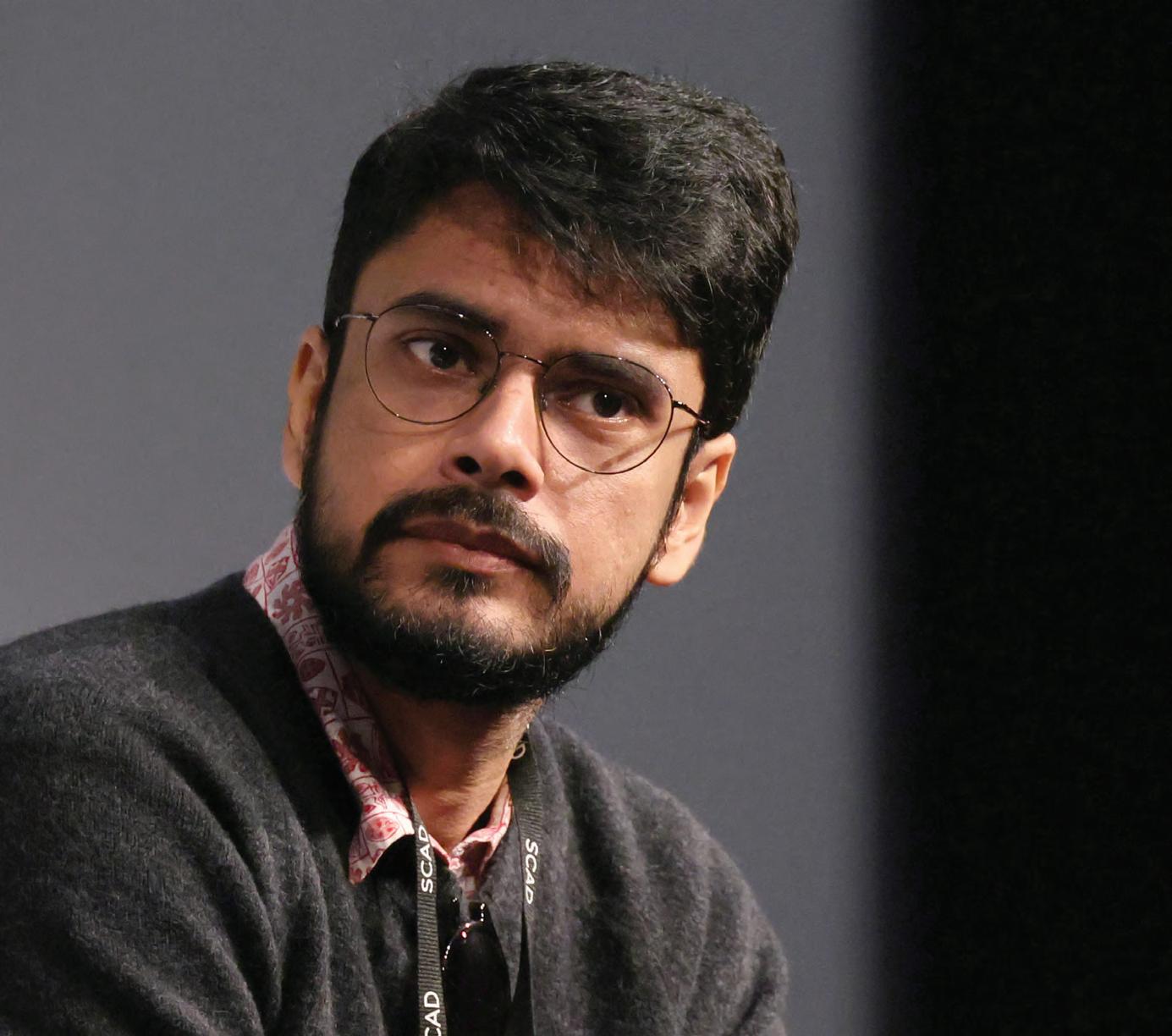
I’ve never had a year like this in my life. My girlfriend said the other day that, apparently, my favorite word these days is “discombobulated”. And I said, “There’s clearly a reason for it.” I don’t know anybody who’s had as many consecutive nights in hotel rooms or has had as many
flights stacked together and all of that. It’s not like a simple-mindedly “Whoa, wonderful!” sort of a thing, because it also takes something… It’s been up and down-y, and rollercoaster-y, but very nice, of course.
Take me back to the origins of the film. Did it start with seeing the birds dropping from the sky?
No, I think it started with a need to engage with the air or deal with the air. In Delhi, everybody’s preoccupied with the air and the almost sentient creepiness that it’s accrued in recent years. I started with this interest in the air and an interest in human/ non-human entanglement, philosophically speaking. And every time you look up at the gray sky and
In a way, Nadeem and Saud provided an embodied and incredible text through which I could sort of open up the film into a lot of issues I was interested in. So, initially, there’s this kind of a conceptual force field that you’re animated by. And then, after that, the sheer blunt force of the irreducible specificity of the brothers themselves and their lives takes over. But the scaffolding of what you’ve started with, the quiet blow of that, still underwrites some of that world
38 DEADLINE.COM/ AWARDSLINE DIA DIPASUPIL/GETTY IMAGES FOR SCAD
The All That Breathes director on the majestic black kite, keeping a safe distance and how bird-watching delivers “a sensorium of life in Delhi”
★ ★ ★ ★ ★
you encounter. It’s really about then blending those two things together, and that’s how the film began.
Do you have a sense of how the film has impacted Nadeem, Saud and Salik?
I think on multiple registers. For one, they’ve been traveling a lot. Nadeem, Saud and Salik came to Cannes. Since then, Nadeem has gone to multiple film festivals, everything from Kraków to Australia to the New York Film Forum, the BAFTAs... Nadeem and Saud are coming for the Oscars. So, it’s a crazy time. There’s more media attention on their [rehabilitation] work than there ever has been. In terms of material help, our producers have very kindly supported their [bird] hospital for a year to come. So, there’s some degree of material alleviation. But having said that, one shouldn’t simple-mindedly overstate—it’s not like a film can, in one fell swoop, change a whole extended family’s life. All I hope for is some kind of an oasis. Now that the film is on HBO, hopefully, the trickle of donations [to the hospital] should swell into a stream. That’s what we’re hoping for.
Have you noticed a difference in the volume of reactions to the film since it debuted on HBO?
Obviously, that increases the audience significantly.
Oh, 100 percent. I’m constantly getting tagged on social media, so that’s usually my only index to figure things out. You keep thinking that you’re making stuff and sending messages in bottles to the wide expanse of the world, and then you only expect a few life rafts. But then, when there’s a full opera of a feedback loop of things, that always takes you by surprise. I’m now in a perpetual state of mild surprise.
In the screenings you’ve done around the world, are there particular moments or interactions with people who’ve seen the film that stand out to you?
Every time somebody comes and says they love the film, it’s meaningful irrespective of how repetitious
it could play. It’s not a diminishing graph at all. Having said that, I love it when people say things like, “I really Googled the brothers after that.” Every time I feel like an audience member has stepped out and looked up at the sky, I feel a bit happy because what it does is it enchants the sky and enchants birds, which is great. I also personally and selfishly feel happy every time somebody uses the word “cinematic.”
That it is. There are so many beautiful images in the film, like the shot of a discarded bag that has a little bit of water pooled in it. Then we see the reflection of an airplane move across it.
To a large degree, that’s the incredible magical skill of the cinematographers Ben Bernhard and Riju Das. But more than anything else, so often, what we call beauty is a function of time. Because if you keep turning up and shooting, at some point, life rewards you with accidents. We have our long track shots ready and if out of the blue, a deflection of something comes, etcetera, that’s great. So much of the documentary is a kind of a radical embrace of the un-scriptedness of the world. I think a large part of what you are describing as beautiful is really a function of time.
I’m wondering what your family’s reaction has been to the extraordinary embrace of your film.
My father passed away very suddenly in the middle of the film. That actually, I believe, gave the film a kind of elegiac, somber quality. Which is why this sense of it being a fever dream ever since is, for me personally, always heightened and intense.
My mom, of course, started from stultified skepticism to that skepticism slowly thawing and now is in grudging recognition of it.
Why do you say “grudging” recognition of it? Are you suggesting— and I don’t want to read too much into it—that maybe your mother's goal in life wasn’t to see you become a filmmaker?
No, my parents were always
incredibly supportive of whatever I wanted to do. And everything I’ve done is because they’ve formed a subsurface of my life. But all wellmeaning parents are a bit skeptical if their child says they’re going to make a nonfiction film about birds that’ll take at least three years. Even if you had a lot of confidence in your child’s ability, you’d be a bit skeptical.
That’s fair. You’ve noted previously that while shooting the film, you kept a respectful distance from the black kites. It wasn’t like you said, “Let me pet the bird,” or that sort of thing. I imagine you haven’t spent much time with birds in the past year because of your travels. But is it pretty consistent that, at least in terms of black kites, you wouldn’t want to be locked in a small room with them?
I mean, they’re not the kind of cute songbirds that elicit petting. You’d have to be an atypical individual to just randomly go up to a black kite and pet it. But in terms of birds, I’m staying in this house in the Hollywood Hills in LA right now, which has a tiny garden patch. I was just
looking at I don’t know what bird because I’m not familiar with the avian ecosystem here, but a bird that reminded me of the warbler in Asia—a grayish bird. It immediately opened familiar rabbit holes from the past where I kept watching it. You start enrolling yourself into the passing of time of the bird itself. You feel like, is it in a stage of play right now?
Because, clearly, it would’ve eaten for the day. It’s the last bit of the day for it and so on. You start going into all of that, and then I think about how most animals in nature are always in a state of almost crippling hunger, and how the brothers [Nadeem and Saud] are able to maintain this dance between looking at the revitalizing, magisterial aspects of nature while also keeping a tab on the kind of crushing agnostic indifference of it—those two things are simultaneous. And they’re able to keep a tab on it. So just that kind of stuff. Which is all to say that the birds haven’t receded from my mind at all.
India, of course, has a huge cinematic tradition. It’s a large nation, and I suspect there is a great deal of pride in what you have accomplished with this film.
I, unfortunately, haven’t been home for too long to be able to soak it all in and verify the exact scale of it. But from what the social media ether tells me, there is that. Of course, we are still awaiting the release [of the film] in India, so hopefully, that should be decided soon. There’s some degree of restlessness to see the film. But yeah, I don’t spend too much time thinking about the intricacies of pride or not.
Are you feeling ready to attend the Academy Awards next month? Do you know what you're going to wear for example?
I emphatically do not, and I will defer that decision. I will delay that decision until the critical mass of urgency reaches a point where it’s become undelayable; it’s not put-downable after that.★
DEADLINE.COM/ AWARDSLINE 39
Every time you look up at the gray sky and you see these lazy black dots gliding in the sky, you feel something. And I wanted to do something on that texture or tone of life, a kind of sensorium of life in Delhi.
FOR THE FIRST TIME SINCE 2020, just before Covid dealt a devastating blow to the industry, exhibitors and awards season, it feels like this year’s Oscar show may return to some sense of normalcy. And with box office hits mixed with acclaimed indies among the 10 Best Picture nominees, this could be the turning point in the recovery of the Academy Awards. At the nominees’ luncheon, in fact, Steven Spielberg was overheard telling Tom Cruise that he may have saved the movie business with Top Gun: Maverick, 2022’s No. 1 movie and a billion-dollar rescue for the industry. On Maverick ’s tail came Avatar: The Way of Water, which became the third biggest global-grossing film of all time. And shock of shocks, both of those long-gestating sequels are Best Picture contenders with 10 nominations between them.
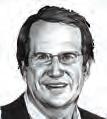
That means audiences may be ready to come back to the Oscars to root for their favorites, something sorely needed. Throw in other box office successes like Elvis and Everything Everywhere All at Once, and you have a recipe for recovery. Interestingly only one streamer, Netflix, with their German WWI film, All Quiet on the Western Front, made the list, but watch out, it has gained some steam and could be Netflix’s first Best Picture winner. The acting races are also tight, particularly Best Actor, where in precursor ceremonies, we have already seen wins by Colin Farrell, Austin Butler and Brendan Fraser. Fascinating year. Here is how I see it playing out, but I caution to check my final online predictions closer to the finish line as this is being written three weeks from Oscar day. A lot can change.
BEST PICTURE
The Academy, for the second year running, has returned to a firm 10 nominees, but the real contenders, based on what we are seeing in the run-up to the Oscars, number about five. Major critics circles rallied around Tár, although the televised Critics Choice Awards heaped riches on Everything Everywhere All at Once. That film has also done well at industry guild awards, especially with its win at the DGA for the Daniels, a key marker in any Oscar season. The Golden Globes anointed two other films: Steven Spielberg’s early front runner, The Fabelmans, for Drama, and Martin McDonagh’s The Banshees of Inisherin for Comedy/Musical. Germany’s All Quiet on the Western Front has crawled into the running with nine Oscar nominations, including Best Picture, and took seven BAFTA awards, including Best Film, Director and Adapted Screenplay. This is a sleeper for Netflix that has big-time buzz. Don’t discount fan and voter favorites Top Gun: Maverick and Elvis, the latter taking four BAFTAs off eight nominations, either. But I have a hunch, mostly based on Oscar voter conversations over the past two months, that it will finally be the year for Netflix.
THE WINNER: All Quiet on the Western Front


BEST ACTOR

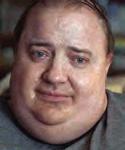
This appears to be the tightest of the four acting categories. Barring any last-minute surprises, it has become a three-way race to the top, one where a few votes could make the difference. Colin Farrell got the season off leaning his way at Venice, where he took the Volpe Cup and has since added a Golden Globe for his career-best work in The Banshees of Inisherin. With three other acclaimed performances all released in 2022, this could be his year. He beat The Whale’s Brendan Fraser at Venice, but Fraser came back and won at Critics Choice, where he also topped Austin Butler’s Golden Globe for Best Actor in a Motion Picture—Drama. Butler also gained tremendous momentum by winning over four U.K. nominees at the BAFTAs, meaning his performance as the musical icon could be transcendent. As Sissy Spacek, Jamie Foxx and Rami Malek have proven, it can be irresistible to Oscar voters when you play a music legend, someone instantly recognizable. That may be the edge.

THE WINNER: Austin Butler, Elvis

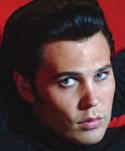
BEST ACTRESS

There were not enough slots to accommodate the great performances by female actors this year. The real shocker in the category was undoubtedly the nomination of Andrea Riseborough for the tiny indie, To Leslie, with a worldwide box office gross of $27,000 and change. A controversial last-minute campaign, largely on a grassroots level by her fellow actors, some very high profile, did the trick. But can she actually win? That is a tall order, and with the publicity being more about the campaign than the richly deserving performance, the answer is probably not. Going for a third Oscar, Cate Blanchett has been the front-runner all season long. Her win at the BAFTAs just re-confirms that there doesn’t appear to be anyone who can catch her. Her most fierce competition would be Everything Everywhere’s Michelle Yeoh, who took the Globe for Comedy/Musical when Blanchett won for Drama. Yeoh is beloved, and her film is popular, as SAG’s nominations for the cast, individually and together, indicate. The betting odds would favor the great Cate, however.

THE WINNER: Cate Blanchett, Tár
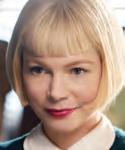

OSCAR HANDICAPS / BY PETE
HAMMOND
40 DEADLINE.COM/ AWARDSLINE

BEST DIRECTOR
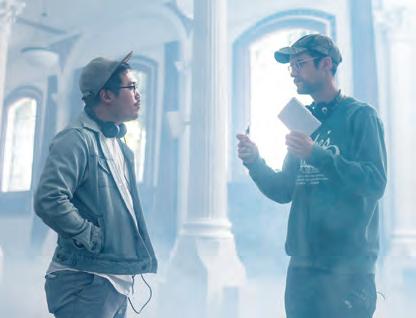
If you go by historical odds, the winners here would have to be the two Daniels, Scheinert and Kwan, who hit paydirt with their little indie that could Everything Everywhere All at Once Their win at Critics Choice was a mere preview of what would come. The big get was taking the DGA’s top directorial prize over that guild’s god, Steven Spielberg, and other Oscar nominees Todd Field and Martin McDonagh. Only eight times in the DGA’s previous 74-year awards history has their winner not gone on to Oscar glory. It looks set up to continue that impressive track record. I think only Spielberg, in making his most personal film ever about his family origins, could derail the path for the Daniels, who would become only the third pair of directors to share the award, after the Coens for No Country for Old Men, and Robert Wise and Jerome Robbins for 1961’s West Side Story. Sentiment for the two-time winner here could tip it to Spielberg, but that DGA recognition tells me otherwise.


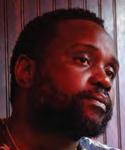
THE WINNER: Daniel Scheinert and Daniel Kwan , Everything Everywhere All at Once
BEST CINEMATOGRAPHY
The shocker here was that the presumed favorite, Claudio Miranda for Top Gun: Maverick, was not even nominated. That leaves us with a more even playing field, but even though the category boasts Roger Deakins, the icon of the field, nominated for the umpteenth time with the single nomination for Empire of Light, individual names don’t appear on the ballot. That also won’t help Elvis’ Mandy Walker, only the third female nominee ever. I expect this will easily become another win for All Quiet on the Western Front, already a BAFTA winner for James Friend’s poetic and stunning photography of the horrors of war.
THE WINNER: James Friend, All Quiet on the Western Front


BEST SUPPORTING ACTOR

The double nominations for The Banshees of Inisherin for both Brendan Gleeson and Barry Keoghan will likely cancel them out, an even greater likelihood at the Oscars after Keoghan, with far less screen time, defeated Gleeson at the BAFTAs. Don’t expect a repeat of that. And despite his advanced age, don’t expect a win for Judd Hirsch, already an Oscar record-setter in terms of the longest span between his first nomination in 1980 and his second in 2022 for his extended cameo in The Fabelmans. And despite being one of only two Black acting contenders this year, don’t expect Brian Tyree Henry, brilliant as he was, to cash in Causeway ’s single nomination. Running the table among critics’ groups, the Globes, Critics Choice, etc., and with only a temporary wrinkle at BAFTA, where his streak ended, expect the endearing Ke Huy Quan to be called to the Dolby Theatre stage on March 12



THE WINNER: Ke Huy Quan, Everything Everywhere All at Once
BEST SUPPORTING ACTRESS

As with Gleeson and Keoghan, with a double nomination act for Everything Everywhere’s Jamie Lee Curtis and Stephanie Hsu, it is hard to imagine that they don’t cancel each other out. If they didn’t, it would likely be veteran Curtis, a member of Hollywood royalty, who would benefit. I was thrilled to see Hong Chau finally nominated after being egregiously overlooked for Downsizing a few years back. Her work as the caregiver in The Whale was exceptional, and she was a hoot in the widely seen The Menu this year, too, but the nomination may be the win. BAFTA winner Kerry Condon played the home field advantage there for The Banshees of Inisherin but seems unlikely to do the same here. Globes and Critics Choice winner Angela Bassett appears on track to be rewarded for her stellar career and to become the first actor to win for a Marvel movie.
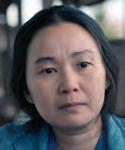
THE WINNER: Angela Bassett, Black Panther: Wakanda Forever

OSCAR HANDICAPS / BY PETE HAMMOND
42 DEADLINE.COM/ AWARDSLINE

BEST ANIMATED FEATURE
Pixar is in the race, and whenever that happens, watch out. Except this year. In line with a handful of Asian films and nominees across multiple categories in this Oscar lineup, Pixar has the well-regarded Turning Red, which Disney mistakenly sent straight to streaming. It has little chance. Dreamworks is back in the race with a hugely successful box office hit, Puss in Boots: The Last Wish, that might have won in any other year. Marcel the Shell With Shoes On seemed to pick up the lion’s share of critics’ awards in the category, but isn’t it really just as much live-action as animation? Cute, but too much of a hybrid to win here. Netflix has two entries, including the beautiful The Sea Beast, which richly deserves to be here with stablemate Guillermo del Toro’s Pinocchio, the BAFTA, Critics Choice, Globes and VES winner, that will win, and not just because its beloved creator has his name in the title.

THE WINNER: Guillermo del Toro’s Pinocchio

BEST INTERNATIONAL FILM



Take this one to the bank. There is only one film here holding all the aces, but overall it is an excellent group of nominees. The moving Belgian entry Close is as deserving of a win here as any foreign language film this year. There is also 84-year-old Polish film veteran Jerzy Skolimowski’s EO, which like Close, was a major prize winner at Cannes, and is a wonderful tale of humanity as seen from the POV of a donkey. Ireland’s first-ever nomination comes from the lovely The Quiet Girl, while Argentina is in the mix with the politically charged Golden Globe-winning Argentina, 1985 The category is rife with possible upsets, but how do you beat a German war film nominated in eight other categories including Best Picture? You don’t.

THE WINNER: Germany, All Quiet on the Western Front


BEST COSTUME DESIGN

If I had a vote here, it would go to multiple Oscar winner Jenny Beavan’s delightful work on Mrs. Harris Goes to Paris, a movie in which the costumes truly share co-star credit with Lesley Manville. If it was the Costume Designers Branch itself and not the entire Academy voting in the finals, I would say this win is a walk, even if it is the least-seen film of the nominees. I am unsure why Everything Everywhere All at Once landed here, and I would be stunned to see it win. Babylon is rich and certainly deserving, as is perennial winner Catherine Martin’s BAFTA-winning Elvis. The smart money seems to be on Ruth Carter’s excellent work on Black Panther: Wakanda Forever, an Oscar winner previously for the original Black Panther. I wonder if voters will think they have already rewarded this franchise and look elsewhere.

THE WINNER: Catherine Martin, Elvis

BEST FILM EDITING
Although not 100% foolproof anymore, this is a key category in which to be nominated if you want to win Best Picture. Nevertheless, it was a little shocking that neither All Quiet on the Western Front nor Avatar: The Way of Water nor The Fabelmans made the cut. Elvis could actually be formidable here, but I think it comes down to either BAFTA winner Paul Rogers for Everything Everywhere All at Once or Top Gun: Maverick. The former just screams editing, a dizzying multiverse romp that hardly slows down to breathe. The latter is simply dazzling, both in the sky and on the ground with Eddie Hamilton’s superlative work. If it can only win one Oscar, it seems this would be the one for Maverick
THE WINNER: Eddie Hamilton, Top Gun: Maverick


OSCAR HANDICAPS / BY PETE HAMMOND
44 DEADLINE.COM/ AWARDSLINE

BEST ORIGINAL SONG
Three musical icons, a Bollywood phenomenon, and a 14-time losing nominee. OK, so look, the Academy got so sick of Diane Warren always being a bridesmaid that they gave her an Honorary Oscar in November. I think that makes it unlikely she will finally break her winless streak in this category with a song from a documentary no one has heard of, and which doesn’t have a single review on Rotten Tomatoes. This is despite Warren being widely admired as a true songwriter on her own, rather than a superstar singer collaborating with others to grab the gold. For instance, Rihanna enlisted Tems, plus the film’s composer, plus the film’s director to help with her stirring Wakanda Forever anthem “Lift Me Up”, which is not to be confused with a past winner in this category, Lady Gaga, who returns with Top Gun: Maverick ’s equally stirring “Hold My Hand”. Both are the type of songs that win here. The dance-themed and lively “Naatu Naatu” from Indian sensation RRR isn’t a great song, but it made for a scene-stealing dance sequence and took Globes and Critics Choice awards. That may be enough.
THE WINNER: “ Naatu Naatu”, RRR

BEST PRODUCTION DESIGN


If there is to be a sweep, All Quiet on the Western Front could win here, but the race is really between Elvis and Babylon for their wide-ranging recreations of time and place in show business history. Elvis had all of its locations from the Deep South to Hollywood to Las Vegas recreated for its shoot in Australia, but you would never know it. Baz Luhrmann’s films have won in this category twice, and there is no reason there won’t be a threepeat for the director whose wife, Catherine Martin, seems to have that magic Oscar touch when it comes to costumes and production design. Except so does Florencia Martin, who won for recreating Quentin Tarantino’s Hollywood of 1969 in Once Upon a Time... in Hollywood and has done the same for Damien Chazelle’s Hollywood circa 1920s. She wins again.
THE WINNER: Florencia Martin, Babylon

BEST MAKEUP AND HAIRSTYLING
Tu rning Brendan Fraser into a 600-pound man, while still making it possible for him to deliver a heartfelt and genuinely human performance, without the prosthetics and makeup work getting in the way, has made The Whale the generally agreed upon favorite here. It's not invincible though, and it will likely find some stiff competition from Elvis and the remarkable team who helped Austin Butler bring The King to life in a way no Elvis impersonator ever could. That film won the BAFTA, and like The Whale, it found some love in multi-categories from the Make-up Artists and Hair Stylists Guild itself. If voters are looking for an alternative, I suppose it could be the transformation of Colin Farrell into The Penguin for The Batman, but don’t lose your office pool going down that road.


THE WINNER: The Whale
BEST ORIGINAL SCORE
For my money, two-time winner Alexandre Desplat’s wonderful score for Guillermo del Toro’s Pinocchio is the hands-down winner, perhaps the French composer’s best work. Oh, wait. It wasn’t even nominated. So who gets it now? The BAFTA went to Volker Bertelmann’s All Quiet on the Western Front, and indeed the score helped make that movie the powerhouse it was. Son Lux’s strong musical work for Everything Everywhere All at Once fit the action to a tee. Carter Burwell’s The Banshees of Inisherin was lyrically Irish where it was needed and another high mark for the composer who has worked with the Coens and Martin McDonagh multiple times. But past La La Land double winner Justin Hurwitz has created what seems to be the most musical of the nominees with Babylon. Ninety-yearold, five-time winner and 53-time nominee John Williams could have the sentimental vote for another fine score for The Fabelmans. If it is a wash between the latter two, look for Bertelmann on the outside.

THE WINNER: Volker Bertelmann, All Quiet on the Western Front



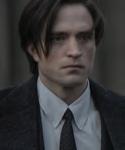
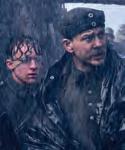

OSCAR HANDICAPS
/ BY PETE HAMMOND
46 DEADLINE.COM/ AWARDSLINE

BEST ADAPTED SCREENPLAY


Of the two screenplay categories this year, this is the one with the fewest strong competitors, but it is also the hardest to call. The BAFTA went to All Quiet on the Western Front, adapted from the Erich Maria Remarque classic anti-war novel with echoes of the original 1930 Best Picture Oscar winner. Telling the story for the first time from the German perspective could land it a win. It is ineligible for the WGA, though, so we won’t be able to count on that for clues. WGA could actually land in Sarah Polley’s lap for the great Best Picture nominee Women Talking. That could boost her momentum just as Oscar voting is going on. It may be between those two, although the category features Living, a remake of the 1952 Akira Kurosawa classic Ikiru by Nobel Prize winner Kazuo Ishiguro, but that may be too little seen by the Academy at large. Top Gun: Maverick shows what brilliance it takes to come back 36 years later and make a bigger splash than the first one did.

THE WINNER: All Quiet on the Western Front



BEST ORIGINAL SCREENPLAY
A terrific category where each of the five are deserving in their own right. Although Martin McDonagh won an Oscar for a live action short a few years ago, he seems ripe to claim his first win for a feature but still hasn’t. With Globe and BAFTA wins, is this his year for The Banshees of Inisherin? If anything is going to stand out, it is his quirky, wonderful writing, which won’t be helped by WGA since it is ineligible there. Palme d’Or winner Triangle of Sadness certainly has its fans, me being one of them, but the competition here is too strong. Todd Field’s first produced feature script in 16 years with Tár is formidable, so is Steven Spielberg’s first nominated script (with Tony Kushner) for The Fabelmans. If the winner is not Banshees, then it is bound to be the Daniels—Scheinert and Kwan—for Everything Everywhere All at Once, which could be the most ‘original’ nominee of the bunch. That may be the reason voters gravitate toward it here more than any other category in which it is nominated. A WGA win won’t hurt at all as Oscar balloting is progressing.
THE WINNER: Everything Everywhere All at Once
BEST SOUND
War films and musicals always have the edge in this category, once split into mixing and sound effects but now combined after the same film seemed to win both categories year after year. All these nominees make sense, with Elvis on the musical side, and All Quiet on the Western Front getting the war vote. In between, we have box office behemoths with familiar titles like Batman, Top Gun and Avatar. Though Elvis’ sound work may not be as obvious, it could be a tiebreaker between the top two most likely winners: All Quiet and Top Gun: Maverick. The former took the BAFTA for being anything but ‘all quiet’ and was superb. But how do you deny the year’s most successful movie an Oscar for one of the key reasons it was so successful? My only concern is that the original Top Gun did not win in this category, but that was 36 years ago, so...
THE WINNER: Top Gun: Maverick



BEST VISUAL EFFECTS


If ever there was a category with a strong favorite almost certain to win it, it is this one with James Cameron’s monumental Avatar: The Way of Water, which swept the VES awards and won the BAFTA. It is almost unbeatable unless somehow All Quiet on the Western Front stages some sort of old-fashioned Oscar sweep, but I doubt that. Also deserving but won’t win here is Top Gun: Maverick, meaning can anything beat this new Avatar and prevent it from following in the footsteps of the old Avatar ? Uh, that would be a ‘no’.
THE WINNER: Avatar: The Way of Water


OSCAR HANDICAPS / BY PETE HAMMOND
48 DEADLINE.COM/ AWARDSLINE
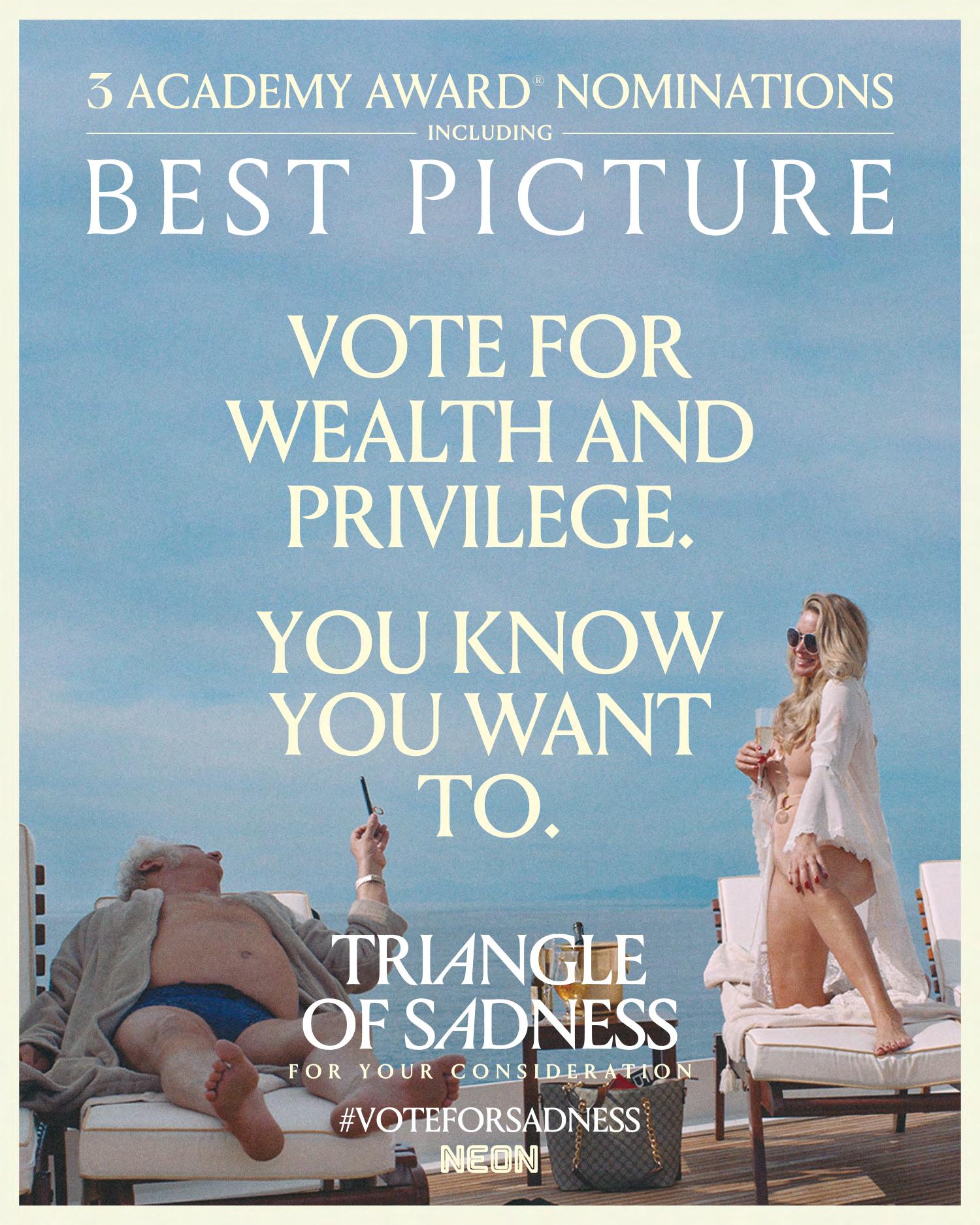
BEST DOCUMENTARY FEATURE
For my money, the five-time Critics Choice winner Good Night Oppy should have run away with this category. It didn’t even make the longlist, which makes me wonder what is wrong with the documentary branch. Nevertheless, I am stuck with what made the cut and in analyzing it. It could go one of many ways. There is the much-acclaimed All That Breathes, which dazzled doc groups this year. There is also the very timely BAFTA-winning Navalny, which benefits from timeliness as it focuses on Vladimir Putin’s courageous critic and Russian political prisoner, Alexei Navalny. There is also past winner Laura Poitras’ Venice Film Festival Golden Lion winner, All the Beauty and the Bloodshed, but some may find it to be two different movies in one, which could hurt its chances. A House Made of Splinters was the surprise entry here, but voters will have to scramble to watch it. That leaves Fire of Love, Nat Geo’s magnificent love story like no other, about a relationship forged in the fierce world of volcanology and two people dedicated to each other and to their mutual pursuit of the world’s most dangerous volcanoes. It’s a winner, no matter how you look at it.
THE WINNER: Fire of Love

BEST DOCUMENTARY SHORT





I combine these last three categories for short films, not just because I haven’t yet seen most of them, but also because these are the categories that can be deal breakers in your office pool. The Doc Short category is divided by two entries from Netflix—The Elephant Whisperers and The Martha Mitchell Effect—and two from The New Yorker Studios—Haulout and Stranger at the Gate—the latter of which counts Malala Yousafzai as an executive producer. The final nominee may be the most accessible and novel of the bunch and the most indie, How Do You Measure a Year? It is a simple father/daughter story in which a father annually filmed his daughter on her birthday from age two to 18, asking the questions of life. Having talked to some voters who have seen these, this one could be the sleeper winner, although all have their proponents to be sure.
THE WINNER: How Do You Measure a Year?

BEST ANIMATED SHORT
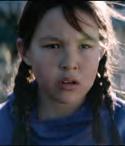


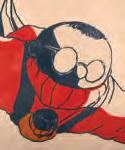

For Animated Short, if voters were looking to award their choice on title alone, it would be a battle between My Year of Dicks and An Ostrich Told Me the World Is Fake and I Think I Believe It. Also, you can never discount the venerable National Film Board of Canada, which has been responsible for many Oscar winners over the decades and this year is repped by The Flying Sailor Ice Merchants is also in the mix, but I think the winner has to be one that just won the BAFTA in their corresponding category, The Boy, the Mole, the Fox and the Horse. Based on the bestselling global book sensation by Charlie Mackesy, it is a gorgeously animated tale that is well-nigh irresistible.
THE WINNER: The Boy, the Mole, the Fox a nd the Horse

BEST LIVE ACTION SHORT
Finally, The New Yorker Studios’ Night Ride and Cynefilms’ The Red Suitcase are among the better-known nominees for Live Action Short. Ivalu, which has a robust publicity campaign, is also spreading the word, along with BAFTA winner An Irish Goodbye. But from Cannes to Telluride and many other festivals, I have to think the front runner is the charming Le Pupille, at least at this point. It comes from acclaimed Italian filmmaker Alice Rohrwacher, five-time Oscar winner Alfonso Cuarón and Disney+ for a delightful musical Christmastime story of a group of orphans left behind at their school over the holidays. It is a charmer. But beware, I reserve the right to change predictions in all the shorts categories, so keep checking online closer to the show itself for the final word.
THE WINNER: Le Pupille
OSCAR HANDICAPS / BY PETE HAMMOND
50 DEADLINE.COM/ AWARDSLINE

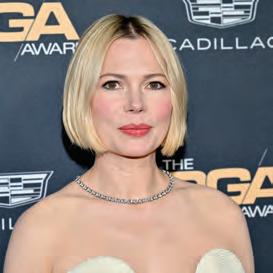



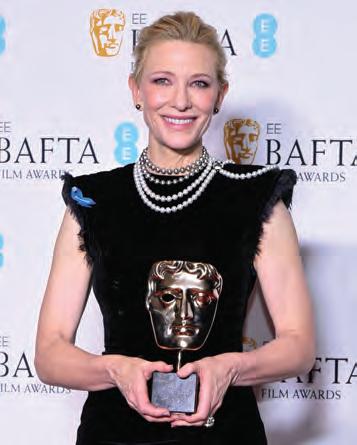
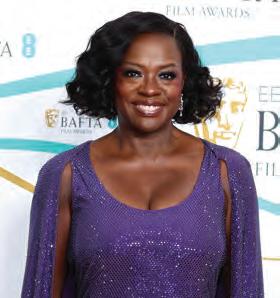


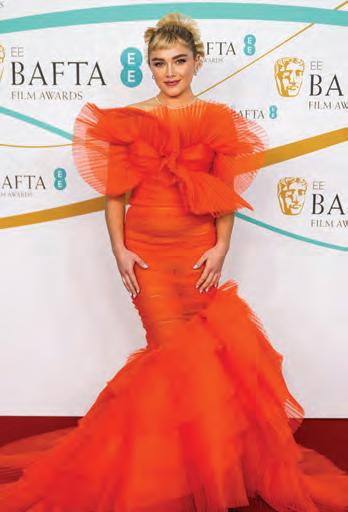

 1. Peter Czernin, Graham Broadbent, Kerry Condon and Martin McDonagh
2. Jonathan Wang, Jamie Lee Curtis and Ke Huy Quan
3. Cate Blanchett
4. Austin Butler
5. Florence Pugh
1. Peter Czernin, Graham Broadbent, Kerry Condon and Martin McDonagh
2. Jonathan Wang, Jamie Lee Curtis and Ke Huy Quan
3. Cate Blanchett
4. Austin Butler
5. Florence Pugh
52 DEADLINE.COM/AWARDSLINE
6. Viola Davis
1
MICHAEL BUCKNER FOR DEADLINE/KARWAI TANG/SAMIR HUSSEIN/MIKE MARSLAND/WIRE IMAGE/JEFF SPICER/GETTY IMAGES/STEPHANE CARDINALE/CORBIS/
3 5 4
2 3 1 4 5 6
1. Michelle Williams
2. Steven Spielberg
3. Daniel Kwan, Stephanie Hsu and Daniel Scheinert
4. Ben Stiller and Christine Taylor
5. Valdez Flagg
2
BAFTA Awards
February 19, 2023
Royal Festival Hall
DGA Awards
February 18, 2023
Beverly Hilton







 By Stevie Wong
By Stevie Wong




 Above, Fraser as Charlie in The Whale ; left, Fraser, Sadie Sink and Darren Aronofsky in New York.
Above, Fraser as Charlie in The Whale ; left, Fraser, Sadie Sink and Darren Aronofsky in New York.









 By Ryan Fleming
By Ryan Fleming
























































 BY DAMON WISE
BY DAMON WISE

 BY RYAN FLEMING
BY RYAN FLEMING


























































































 1. Peter Czernin, Graham Broadbent, Kerry Condon and Martin McDonagh
2. Jonathan Wang, Jamie Lee Curtis and Ke Huy Quan
3. Cate Blanchett
4. Austin Butler
5. Florence Pugh
1. Peter Czernin, Graham Broadbent, Kerry Condon and Martin McDonagh
2. Jonathan Wang, Jamie Lee Curtis and Ke Huy Quan
3. Cate Blanchett
4. Austin Butler
5. Florence Pugh

